#may 9 2019
Explore tagged Tumblr posts
Text

may 9, 2019 | five years ago today
taylor’s entertainment weekly cover released

she was wearing a collection of symbolic pins, each of which were explained except for two taylor decided to “keep the special meaning” to herself:
the pride heart and “i tried” daisy tombstone

#may 9 2019#may 9#2019#queer flagging#pride flags#daisies#entertainment weekly cover#gaylor throwbacks#gaylor#gaylor swift#lgbetty
31 notes
·
View notes
Text
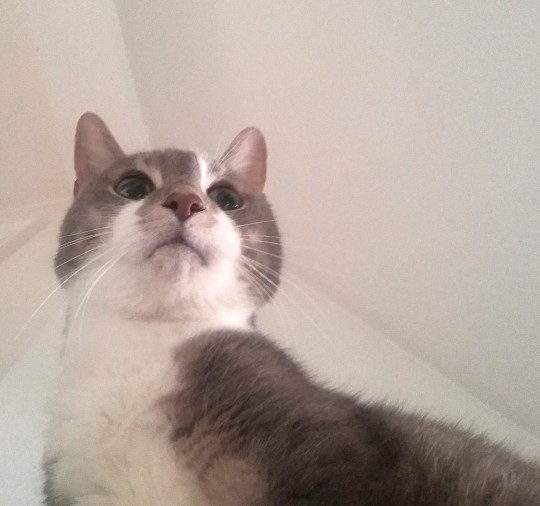
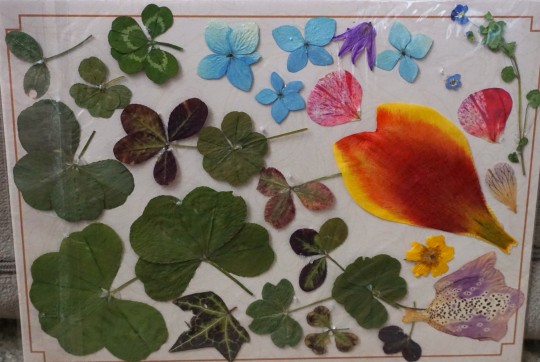
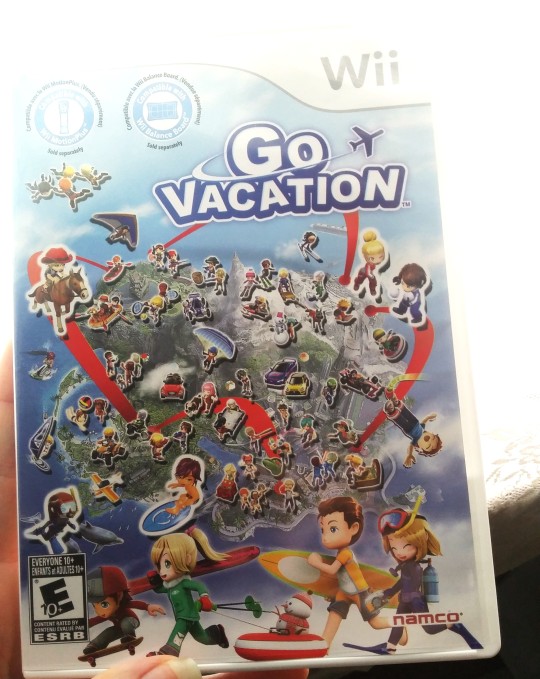
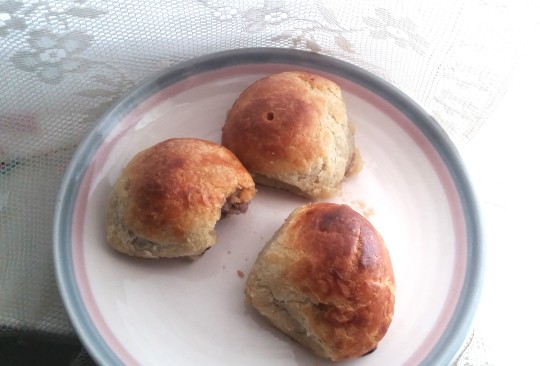



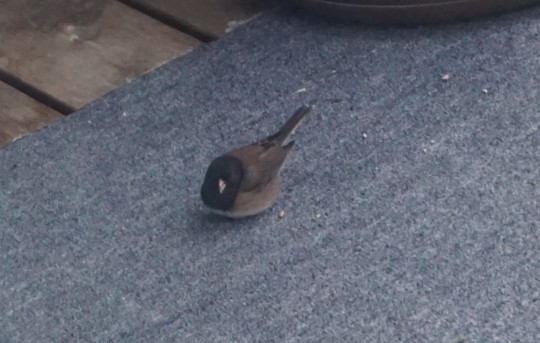
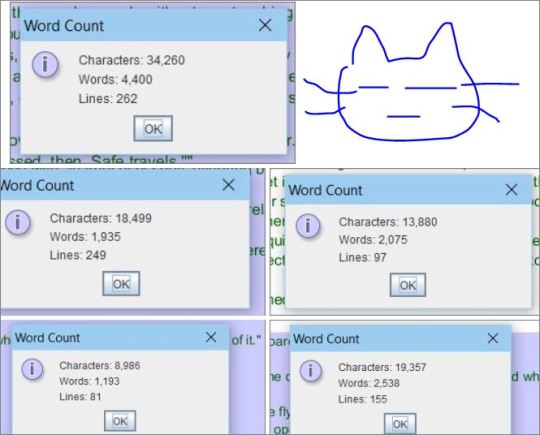


Recent-ish things ~
#photo diary#1 - love this image of Noodle.. such a weird angle that makes his head look entirely round like a puff ball or something#2 - a more recent (still from months ago) collection of my pressed flowers and 4 leaf clovers I found.#3. Being one of the only people in 2024 still going 'hee heee I've just bought a new wii game!' but.. I have. >:3#It's kind of like Wii Sports Resort but is like.. open world? so your character can actually walk around and stuff. REALLY makes me#wish I had the type of set up where I could record video from my wii and stuff like some gaming youtubers have. I think it'd be a really#fun game to play on video and to DOCUMENT it!!! I keep wishing I could screenshot my little guy walking around but I caaant..#I've literally just been taking out my phyiscal camera and photographing the screen which always looks bad.. augh..#4. Something in the froxen food aisle called 'Wellington Bites' a play on beef wellington. suprisingly good actually. but I guess anything#with like beef and mushrooms usually is. But it seems like.. oddly decent for frozen food stuff.#5 - boye looking Round again.. 6 - updated score in the wii fit minigame again. This time less than 4 seconds#for each round? which may be a record for me? 7 & 8 - fat bird in the snow. fatt bird in the SNOW!! Hoping that climate change and H5N1#don't eventually remove all trace of birds and winter weather from my life in the future... -_-#9 - ..ough... a few paltry writings.. Except for the one day of 4000 words. But for the most part I have been making soo litte progress#because of the holidays and drs appointments and such a rush of all these other mind distracting things.. Or if I'm not doing something the#I'm feeling tired from having PREVIOUSLY done something so I waste the whole day being sleepy and headachey... GRR...#the funny thing is that like many many years ago I wrote a note on my wall saying 'FOCUS! write 2hr a day or more or youre going to finish#your game in 2025!!!' - which back in 2018 when I wrote it was like unimaginably far into the future but now... ahem.. hem... I guess that#is quite literally the case LOL. To my credit I did parctically abandon it entirely since late 2019 and JUST now picked up really#trying to focus on it in mid 2024 but still... My '''ridiculous'' projection being actually likely the correct one..#10 - I just thoughtit would be silly to put a bunch of keychain things on the wii remote. imagine playing this way. getting constantly#jabbed in the hand by plastic bits. and the jingling clinking noise it would be always making lol#11 - sky.. huzzah for the sky as always. Clouds my beloved#Gr.. I just really want to wriiite. My new years hopes are to finish my game and to get stuff set up to start selling sculptures again.#AND then maybe do more game videos lol... I miss playing games. I dont think I've posted on that youtube for like 5 months#I've just had so much appointments and Things and Stuff and focusing so much on other projects. But that is the thing that really#feels relaxing and fun for me. so like.. 1. finish game 2. sell sculpture/make sculpture 3. play games 4. find more friends#and social connection and networking or whatever the hell people have to do to be successful 5. do more costume/outfits.#<( saying this all on a day where I did none of those things LOL... I got erm.. maybe 400 words done today.. >:'3c )#6 is MOVE away from the evil west coast (hot.. fires in summer. etc) but like. not happening unless I suddenly become a millionaire so. -_-
9 notes
·
View notes
Text
Thursday, 9 May 2019
Zayn releases a new single, A Whole New World, his collaboration with Zhavia Ward. It's on the soundtrack of Disney's Aladdin as well as the end credits. Directed by Philip Endelman, the video clip shows Zayn and Zhavia singing the romantic ballad in various parts of Manhattan in the evening, including Central Park's Bethesda Terrace




credits: keepingupwithzayn's Tumblr





credits: keepingupwithzayn's Tumblr
youtube
credits: DisneyMovieVEVO's YouTube channel
7 notes
·
View notes
Text





























The Carbide & Carbon Building was designated a Chicago Landmark on May 9, 1996.
#230 North Michigan Avenue#Art Deco#one of my favorite Art Deco skyscrapers#Chicago Landmark#9 May 1996#anniversary#US history#detail#travel#Carbide & Carbon Building#Burnham Brothers#the Loop#tourist attraction#landmark#downtown#Illinois#Chicago#dark green terra cotta#black granite#gold#Midwestern USA#Great Lakes Region#original photography#USA#vacation#cityscape#architecture#summer 2016#2019
4 notes
·
View notes
Text
.
#god being drunk after not being drunk for a hot minute is so odd and fun#I know the rules I know how it works but also I don’t and my tolerance is shitttyyyyyyyyyyyyy#that much alcohol wouldn’t have made a DENT in me this time 9 months ago#and yet rn I cannot sit up without going funny#and I remember all the temperature nonsense I experience when drunk but I keep forgetting I’m drunk and it’s normal#anyway this may have been the birthday I thought would be awful but it’s been a fucking blast and one of my best since 2019? 2018??? sooooo
2 notes
·
View notes
Text
[Gif of a video game detective looking guy holding a cigarette as he ages from like 25 to 60 in under two seconds]
#i didn't vote on that acct only this one#however i'm taking my tags#i don't remember 2018-2020 by those words#despite knowing for sure i was on on those days#because i was bedridden then and had nothing better to do#actually wait 2018 i may have been working#but 2019 and 2020 i def was not#(i was able to work for about 9 months after a back procedure i had. it worked but it was supremely traumatic so I#haven't had it done again#anywho#i remember the tophats confused the fuck out of me bc i could only be on my phone until after dinner#which is when i finally saw all the hats#mishapocalypse easily#genuinely#i was actually trading mishapocalypse posts w one of my friends who was also here at that time#it was a fun day#for all of the few hours I was able to be on that day#(it was a school day and I was in high school)
18K notes
·
View notes
Text
Nimona: a Story of Trans Rights, Queer Solidarity, and the Battle Against Censorship
by Ren Basel renbasel.com
The 2023 film Nimona, released on Netflix after a tumultuous development, is a triumph of queer art. While the basic plot follows a mischievous shapeshifter befriending a knight framed for murder, at its heart Nimona is a tale of queer survival in the face of bigotry and censorship. Though the word “transgender” is never spoken, the film is a deeply political narrative of trans empowerment.
The film is based on a comic of the same name, created by Eisner-winning artist N.D. Stevenson. (1) Originally a webcomic, Nimona stars the disgraced ex-knight Ballister Blackheart and his titular sidekick, teaming up to topple an oppressive regime known as the Institution. The webcomic was compiled into a graphic novel published by Harper Collins on May 12, 2015. (2)
On June 11, 2015, the Hollywood Reporter broke the news Fox Animation had acquired rights to the story. (3) A film adaptation would be directed by Patrick Osborne, written by Marc Haimes, and produced by Adam Stone. Two years later, on February 9, 2017, Osborne confirmed the film was being produced with the Fox-owned studio Blue Sky Animation, and on June 30 of that same year, he claimed the film would be released Valentine’s Day 2020. (4)
Then the Walt Disney Company made a huge mess.
On December 14, 2017, Disney announced the acquisition of Twenty-First Century Fox, Inc. (5) Industry publications began speculating the same day about Blue Sky’s fate, though nothing would be confirmed until after the deal’s completion on March 19, 2019. (6) At first it seemed the studio would continue producing films under Disney’s governance, similar to Disney-owned Pixar Animation. (7)
The fate of the studio—and Nimona’s film adaptation—remained in purgatory for two years. During that time, Patrick Osborne left over reported creative differences, and directorial duties were taken over by Nick Bruno and Troy Quane. (8) Bruno and Quane continued production on the film despite Blue Sky’s uncertain future.
The killing blow came on February 9, 2021. Disney shut down Blue Sky and canceled Nimona, the result of economic hardship caused by COVID-19. (9) Nimona was seventy-five percent completed at the time, set to star Chloë Grace Moretz and Riz Ahmed. (10)
While COVID-19 caused undeniable financial upheaval for the working class, wealthy Americans fared better. (11) Disney itself scraped together enough to pay CEO Bob Iger twenty-one million dollars in 2020 alone. (12) Additionally, demand for animation spiked during the pandemic’s early waves, and Nimona could have been the perfect solution to the studio’s supposed financial woes. (13) Why waste the opportunity to profit from Blue Sky’s hard work?
It didn’t take long for the answer to surface. Speaking anonymously to the press, Blue Sky workers revealed the awful truth: Disney may have killed Nimona for being too queer. The titular character was gender-nonconforming, the leading men were supposed to kiss, and Disney didn’t like it. (14) While Disney may claim COVID-19 as the cause, it is noteworthy that Disney representatives saw footage of two men declaring their love, and not long after, the studio responsible was dead. (15) Further damning evidence came in February of 2024, when the Hollywood Reporter published an article quoting co-director Nick Bruno, who named names: Disney’s chief creative officer at the time, Alan Horn, was adamantly opposed to the film’s “gay stuff.” (16)
Disney didn’t think queer art was worthy of their brand, and it isn’t the first time. “Not fitting the Disney brand” was the justification for canceling Dana Terrace’s 2020 animated series The Owl House, which featured multiple queer characters. (17) Though Terrace was reluctant to assume queerphobia caused the cancellation, Disney’s anti-queer bias has been cited as a hurdle by multiple showrunners, including Terrace herself. (18) The company’s resistance to queer art is a documented phenomenon.
While Nimona’s film cancellation could never take N.D. Stevenson’s comic from the world, it was a sting to lose such a powerful queer narrative on the silver screen. American film has a long history of censoring queerness. The Motion Picture Production Code (commonly called the Hays Code) censored queer stories for decades, including them under the umbrella of “sex perversion.” (19) Though the Code was eventually repealed, systemic bigotry turns even modern queer representation milestones into battles. In 2018, when Rebecca Sugar, creator of the Cartoon Network series Steven Universe, succeeded in portraying the first-ever same-sex marriage proposal in American children’s animation, the network canceled the show in retaliation. (20)
When queer art has to fight so hard just to exist, each loss is a bitter heartbreak. N.D. Stevenson himself expressed sorrow that the world would never see what Nimona’s crew worked so hard to achieve. (21)
Nimona, however, is hard to kill.
While fans mourned, progress continued behind the scenes. Instead of disappearing into the void as a tax write-off, the film was quietly scooped up by Megan Ellison of Annapurna Pictures. (22) Ellison received a call days before Disney’s death blow to Blue Sky, and after looking over storyboard reels, she decided to champion the film. With Ellison’s support, former Blue Sky heads Robert Baird and Andrew Millstein did their damnedest to find Nimona a home. (23)
Good news arrived on April 11, 2022, when N.D. Stevenson made a formal announcement on Twitter (now X): Nimona was gloriously alive, and would release on Netflix in 2023. (24) Netflix confirmed the news in its own press release, where it also provided details about the film’s updated cast and crew, including Eugene Lee Yang as Ambrosius Goldenloin alongside Riz Ahmed’s Ballister Boldheart (changed from the name Blackheart in the comic) and Chloë Grace Moretz as Nimona. (25) The film was no longer in purgatory, and grief over its death became anticipation for its release.
Nimona made her film debut in France, premiering at the Annecy International Animation Film Festival on June 14, 2023 to positive reviews. (26) Netflix released the film to streaming on June 30, finally completing the story’s arduous journey from page to screen. (27)
When the film begins, the audience is introduced to the world through a series of illustrated scrolls, evoking the storybook intros of Disney princess films such as 1959’s Sleeping Beauty. The storybook framing device has been used to parody Disney in the past, perhaps most famously in the 2001 Dreamworks film Shrek. Just as Shrek contains parodies of the Disney brand created by a Disney alumnus, so, too, does Nimona riff on the studio that snubbed it. (28)
Nimona’s storybook intro tells the story of Gloreth, a noble warrior woman clad in gold and white, who defended her people from a terrible monster. After slaying the beast, Gloreth established an order of knights called the Institute (changed from the Institution in the comic) to wall off the city and protect her people.
Right away, the film introduces a Christian dichotomy of good versus evil. Gloreth is presented as a Christlike figure, with the Institute’s knights standing in as her saints. (29) Her name is invoked like the Christian god, with characters uttering phrases such as “oh my Gloreth” and “Gloreth guide you.” The film’s design borrows heavily from Medieval Christian art and architecture, bolstering the metaphor.
Nimona takes place a thousand years after Gloreth’s victory. Following the opening narration, the audience is dropped into a setting combining Medieval aesthetics with futuristic science fiction, creating a sensory delight of neon splashed across knights in shining armor. It’s in this swords-and-cyborgs city that a new knight is set to join the illustrious ranks of Gloreth’s Institute, now under the control of a woman known only as the Director (voiced by Frances Conroy). That new knight is our protagonist, Ballister Boldheart.
The film changes several things from the original. The comic stars Lord Ballister Blackheart, notorious former knight, long after his fall from grace. He has battled the Institution for years, making a name for himself as a supervillain. The film introduces a younger Ballister Boldheart who is still loyal to the Institute, who believes in his dream of becoming a knight and overcomes great odds to prove himself worthy. In the comic, Blackheart’s greatest rival is Sir Ambrosius Goldenloin, with whom he has a messy past. The film shows more of that past, when Goldenloin and Boldheart were young lovers eager to become knights by each other’s side.
There is another notable change: in the comic, Goldenloin is white, and Blackheart is light-skinned. In the film, both characters are men of color—specifically, Boldheart is of Pakistani descent, and Goldenloin is of Korean descent, matching the ethnicity of their respective voice actors. This change adds new themes of institutional racism, colorism, and the “model minority” stereotype. (30)
The lighter-skinned Goldenloin is, as his name suggests, the Institute’s golden boy. He descends from the noble lineage of Gloreth herself, and his face is emblazoned on posters and news screens across the city. He is referred to as “the most anticipated knight of a generation.” In contrast, the darker-skinned Boldheart experiences prejudice and hazing due to his lower-class background. His social status is openly discussed in the news. He is called a “street kid” and “controversial,” despite being the top student in his class. The newscasters make sure everyone knows he was only given the chance to prove himself in the Institute because the queen, a Black woman with established social influence, gave him her personal patronage. Despite this patronage, when the news interviews citizens on the street, public opinion is firmly against Boldheart.
To preserve the comic’s commentary on white privilege, some of Goldenloin’s traits were written into a new, white character created for the film, Sir Thoddeus Sureblade (voiced by Beck Bennett). Sureblade’s vitriol against both Boldheart and Goldenloin allowed Goldenloin to become a more sympathetic character, trapped in the system just as much as Boldheart. (31) This is emphasized at other points in the film when the audience sees Sureblade interact with Goldenloin without Boldheart present, berating the only person of color left in the absence of the darker-skinned man.
The day Boldheart is to be knighted, everything goes wrong. As Queen Valerin (voiced by Lorraine Toussaint) performs the much-anticipated knighting ceremony, a device embedded in Boldheart’s sword explodes, killing her instantly. Though Boldheart is not to blame, he is dubbed an assassin instead of a knight. In an instant, he becomes the most wanted man in the kingdom, and Queen Valerin’s hopes for progress and social equality seem dead with her. Boldheart is gravely injured in the explosion and forced to flee, unable to clear his name.
Enter Nimona.
The audience meets the titular character in the act of vandalizing a poster of Gloreth, only to get distracted by an urgent broadcast on a nearby screen. As she approaches, a bystander yells that she’s a “freak,” in a manner reminiscent of slurs screamed by passing bigots. Nimona has no time for bigots, spraying this one in the face with paint before tuning in to the news.
“Everyone is scared,” declare the newscasters, because queen-killer Ballister Boldheart is on the run. The media paints him as a monster, a filthy commoner who never deserved the chances he was given, and announce that, “never since Gloreth’s monster has anything been so hated.” This characterization pleases Nimona, and she declares him “perfect” before scampering off to find his hiding place.
It takes the span of a title screen for her to track him down, sequestered in a makeshift junkyard shelter. Just before Nimona bursts into the lair, the audience sees Boldheart’s injuries have resulted in the amputation of his arm, and he is building a homemade prosthetic. This is another way he’s been othered from his peers in an instant, forced to adapt to life-changing circumstances with no support. Where he was so recently an aspiring knight with a partner and a dream, he is now homeless, disabled, and isolated.
A wall in the hideout shows a collection of news clippings, suspects, and sticky notes where Boldheart is trying to solve the murder and clear his name. His own photo looks down from the wall, captioned with a damning headline: “He was never one of us—knights reveal shocking details of killer’s past.” It evokes real-world racial bias in crime reporting, where suspects of color are treated as more violent, unstable, and prone to crime than white suspects. A 2021 report by the Equal Justice Initiative and the Global Strategy Group compiled data on this phenomenon, focusing on the stark disparity between coverage of white and Black suspects. (32)
Nimona is not put off by Boldheart’s sinister media reputation. It’s why she tracked him down in the first place. She’s arrived to present her official application as Boldheart’s villain sidekick and help him take down the Institute. Boldheart brushes her off, insisting he isn’t a villain. He has faith in his innocence and in the system, and leaves Nimona behind to clear his name.
When he is immediately arrested, stripped of his prosthetic, and jailed, Nimona doesn’t abandon him. She springs a prison break, and conveys a piece of bitter wisdom to the fallen knight: “[O]nce everyone sees you as a villain, that’s what you are. They only see you one way, no matter how hard you try.”
Nimona and Boldheart are both outcasts, but they are at different stages of processing the pain. Boldheart is deep in the grief of someone who tried to adhere to the demands of a biased system but finally failed. He is the newly cast-out, who gave his entire life to the system but still couldn’t escape dehumanization. His pain is a fresh, raw wound, where Nimona has old scars. She embodies the deep anger of those who have existed on the margins for years. Where Boldheart wants to prove his innocence so he can be re-accepted into the fold, Nimona’s goal is to tear the entire system apart. She finds instant solidarity with Boldheart based solely on their mutual status as outsiders, but Boldheart resists that solidarity because he still craves the system’s familiar structure.
In the comic, Blackheart’s stance is not one of fresh grief, since, just like Nimona, he has been an outsider for some time. Instead, Blackheart’s position is one of slow reform. He believes the system can be changed and improved, while Nimona urges him to demolish it entirely. In both versions, Ballister thinks the system can be fixed by removing specific corrupt influences, where Nimona believes the government is rotten to its foundations and should be dismantled. Despite their ideological differences, Nimona and Ballister ally to survive the Institute’s hostility.
The allyship is an uneasy truce. During the prison break, Nimona reveals that she’s a shapeshifter, able to change into whatever form she pleases. Boldheart reflexively reaches for his sword, horrified that she isn’t human. She is the exact sort of monster he has been taught to fear by the Institute, and it’s only because he needs her help that he overcomes his reflex and sticks with her.
Nimona’s shapeshifting functions as a transgender allegory. The comic’s author, N.D. Stevenson, is transgender, and Nimona’s story developed alongside his own queer journey. (33) The trans themes from the comic are emphasized in the film, with various pride flags included in backgrounds and showcased in the art book. (34) Directors Bruno and Quane described the film as “a story about acceptance. A movie about being seen for who you truly are and a love letter to all those who’ve ever shared that universal feeling of being misunderstood or like an outsider trying to fit in.” (35)
When Boldheart asks Nimona what she is, she responds with only “Nimona.” When he calls her a girl, she retorts that she’s “a lot of things.” When she transforms into another species, she specifies in that moment that she’s “not a girl, I’m a shark.” Later, when she takes the form of a young boy and Boldheart comments on it, saying “now you’re a boy,” her response is, “I am today.” She defies easy categorization, and she likes it that way.
About her shapeshifting, Nimona says “it feels worse if I don’t do it” and “I shapeshift, then I’m free.” When asked what happens if she doesn’t shapeshift, she responds, “I wouldn’t die-die, I just sure wouldn’t be living.” Every time she discusses her transformations, it carries echoes of transgender experience—and, as it happens, Nimona is not N.D. Stevenson’s only shapeshifting transgender character. During his tenure as showrunner for She-Ra and the Princesses of Power (Netflix/Dreamworks, 2018-2020), Stevenson introduced the character Double Trouble. Double Trouble previously existed at the margins of She-Ra lore, but Stevenson’s version was a nonbinary shapeshifter using they/them pronouns. (36) While Nimona uses she/her pronouns throughout both comic and film, just like Double Trouble her gender presentation is as fluid as her physical form.
Boldheart, like many cisgender people reacting to transgender people, is uncomfortable with Nimona. He declares her way of doing things “too much,” and insists they try to be “inconspicuous” and “discreet.” He worries whether others saw her, and, when she is casually in a nonhuman form, he asks if she can “be normal for a second.” He claims to support her, but says it would be “easier if she was a girl” because “other people aren’t as accepting.” His discomfort evokes fumbled allyship by cisgender people, and Nimona emphasizes the allegory by calling Boldheart out for his “small-minded questions.” While the alliance is uneasy, Boldheart continues working with Nimona to clear his name. They are the only allies each other has, and their individual survival is dependent on them working together.
When the duo gain video proof of Boldheart’s innocence, they learn the bomb that killed Queen Valerin was planted by the Director. Threatened by a Black woman using her influence to elevate a poor, queer man of color, the white Director chose to preserve the status quo through violence.
Nimona is eager to get the video on every screen in the city, but Boldheart wants to deal with the issue internally, out of the public eye. He insists “the Institute isn’t the problem, the Director is.” This belief is what also leads the comic’s Blackheart to reject Nimona’s idea that he should crown himself king. He is focused on reforming the existing power structure, neither removing it entirely nor taking it over himself.
Inside the Institute, the Director has been doing her best to set Goldenloin against his former partner. Despite his internal misgivings and fear of betraying someone he loves, Goldenloin does his best to adhere to his prescribed role. As the Director reminds the knights, they are literally born to defend the kingdom, and it’s their sacred duty to do so—especially Goldenloin, who carries Gloreth’s holy blood. This blood connection is repeated throughout the film, and used by the Director to exploit Goldenloin. He’s the Institute’s token minority, put on a gilded pedestal and treated as a symbol instead of a human being.
Goldenloin is a pretty face for propaganda posters, and those posters can be seen throughout the film. They proclaim Gloreth’s majesty, the power of the knights, and remind civilians that the Institute is necessary to “protect our way of life.” A subway PSA urges citizens, “if you see something, slay something,” in a direct parody of the real-world “if you see something, say something” campaign by the United States Department of Homeland Security. (37)
The film is not subtle in its political messaging. When Boldheart attempts to prove his innocence to Goldenloin and the assembled knights, he reaches towards his pocket for a phone. The Director cries that Boldheart has a weapon, and Sureblade opens fire. Though the shot hits the phone and not Boldheart, it carries echoes of real-world police brutality against people of color. Specifically, the use of a phone evokes cases such as the 2018 murder of Stephon Clark, a young Black man who was shot and killed by California police claiming Clark’s cell phone was a firearm. (38) The film does not toy with vague, depoliticized themes of coexistence and tolerance; it is a direct and pointed allegory for contemporary oppression in the United States of America.
Forced to choose between love for Boldheart and loyalty to the Institute, Goldenloin chooses the Institute. He calls for Boldheart’s arrest, and this is the moment Boldheart finally agrees to fight back and raise hell alongside Nimona. When Goldenloin calls Nimona a monster during the ensuing battle, Boldheart doesn’t hesitate to refute it. He expresses his trust in her, and it’s clear he means it. He’s been betrayed by someone he cared about and thought he could depend on, and this puts him in true solidarity with Nimona for the first time.
During the fight, Nimona stops a car from crashing into a small child. She shapeshifts into a young girl to appear less threatening, but it doesn’t work. The child picks up a sword, pointing it at Nimona until an adult pulls them away to hide. When Nimona sees this hatred imprinted in the heart of a child, it horrifies her.
After fleeing to their hideout, Nimona makes a confession to Boldheart: she has suicidal ideations. So many people have directed so much hatred toward her that sometimes she wants to give in and let them kill her. In the real world, a month after the film’s release, a study from the Williams Institute at the UCLA School of Law compiled data about suicidality in American transgender adults. (39) Researchers found that eighty-one percent have thought about suicide, compared to just thirty-five percent of cisgender adults. Forty-two percent have attempted suicide, compared to eleven percent of cisgender adults. Fifty-six percent have engaged in self-harm, compared to twelve percent of cisgender adults.
When Boldheart offers to flee with her and find somewhere safe together, Nimona declares they shouldn’t have to run. She makes the decision every trans person living in a hostile place must make: do I leave and save myself, or do I stay to fight for my community? The year the film was released, the Trans Legislation Tracker reported a record-breaking amount of anti-trans legislation in the United States, with six hundred and two bills introduced throughout twenty-four states. (40) In February 2024, the National Center for Transgender Equality published data on their 2022 U.S. Transgender Survey, revealing that forty-seven percent of respondents thought about moving to another area due to discrimination, with ten percent actually doing so. (41)
Despite the danger, Nimona and Boldheart work diligently against the Institute. When they gain fresh footage proving the Director’s guilt, they don’t hesitate to upload it online, where it garners rapid attention across social and news media. Newscasters begin asking who the real villain is, anti-Institute sentiment builds, and citizens protest in the streets, demanding answers. The power that social media adds to social justice activism is true in the real world as it is in the film, seen in campaigns such as the viral #MeToo hashtag and the Black Lives Matter movement. (42) In 2020, polls conducted by the Pew Research Center showed eight in ten Americans viewed social media platforms as either very or somewhat effective in raising awareness about political and social topics. In the same survey, seventy-seven percent of respondents believed social media is at least somewhat effective in organizing social movements. (43)
In reaction to the media firestorm, the Director issues a statement. She outs Nimona as a shapeshifter, and claims the evidence against the Institute is a hoax. Believing the Director, Goldenloin contacts Boldheart for a rendezvous, sans Nimona. From Goldenloin’s perspective, Boldheart is a good man who has been deceived by the real villain, Nimona. He tells Boldheart about a scroll the Director found, with evidence that Nimona is Gloreth’s original monster, still alive and terrorizing the city. Goldenloin wants to bring Boldheart back into the knighthood and resume their relationship, and though that’s what Boldheart wanted before, his solidarity with Nimona causes him to reject the offer.
Though he leaves Goldenloin behind, Boldheart’s suspicion of Nimona returns. Despite their solidarity, he doesn’t really know her, so he returns home to interrogate her. In the ensuing argument, he reverts to calling her a monster, but only through implication—he won’t say the word. Like a slur, he knows he shouldn’t say it anymore, but that doesn’t keep him from believing it.
Boldheart’s actions prove to Nimona that nowhere is safe. There is no haven. Her community will always turn on her. She flees, and in her ensuing breakdown, the audience learns her backstory. She was alone for an unspecified length of time, never able to fit in until meeting Gloreth as a little girl. Nimona presents herself to Gloreth as another little girl, and Gloreth becomes Nimona’s very first friend. Even when Nimona shapeshifts, Gloreth treats her with kindness and love.
Then the adults of Gloreth’s village see Nimona shapeshift, and the word “monster” is hurled. Torches and pitchforks come out. At the adults’ panic, Gloreth takes up a sword against Nimona, and the cycle of bigotry is transferred to the next generation. The friendship shatters, and Nimona must flee before she can be killed.
After losing Boldheart, seemingly Nimona’s only ally since Gloreth’s betrayal, Nimona’s grief becomes insurmountable. She knows in her heart that nothing will ever change. She’s been hurt too much, by too many, cutting too deeply. To Nimona, the world will only ever bring her pain, so she gives in. She transforms into the giant, ferocious monster everyone has always told her she is, and she begins moving through the city as the Institute opens fire.
When Ballister sees Nimona’s giant, shadowy form, he realizes the horrific pain he caused her. He intuits that Nimona isn’t causing destruction for fun, she’s on a suicide march. She’s given up, and her decision is the result of endless, systemic bigotry and betrayal of trust. Her rampage wouldn’t be happening if she’d been treated with love, support, and care.
Nimona’s previous admission of suicidal ideation repeats in voiceover as she prepares to impale herself on a sword pointed by a massive statue of Gloreth. Her suicide is only prevented because Ballister steps in, calling to her, apologizing, saying he sees her and she isn’t alone. She collapses into his arms, once again in human form, sobbing. Boldheart has finally accepted her truth, and she is safe with him.
But she isn’t safe from the Director.
In a genocidal bid she knows will take out countless civilian lives, the Director orders canons fired on Nimona. Goldenloin tries to stop her, finally standing up against the system, but it’s too late. The Director fires the canons, Nimona throws herself at the blast to protect the civilians, and Nimona falls.
When the dust settles, the Director is deposed and the city rebuilds. Boldheart and Goldenloin reconnect and resume their relationship. The walls around the city come down, reforms take hold in the Institute, and a memorial goes up to honor Nimona, the hero who sacrificed her life to reveal the Director’s corruption.
Nimona, however, is hard to kill.
Nimona originally had a tragic ending, born of N.D. Stevenson’s own depression, but that hopelessness didn’t last forever. (44) Though Nimona is defeated, she doesn’t stay dead. Through the outpouring of love and support N.D. Stevenson received while creating the original webcomic, he gained the community and support he needed to create a more hopeful ending for Nimona’s story—and himself.
The comic’s ending is bittersweet. Nimona can’t truly die, and eventually restores herself. She allows Blackheart to glimpse her, so he knows she survived, but she doesn’t stay. She still doesn’t feel safe, and is assumed to move on somewhere new. Blackheart never sees Nimona again.
The film’s ending is more hopeful. There is a shimmer of pink magic as Nimona announces her survival, and the film ends with Boldheart’s elated exclamation. Even death couldn’t keep her down. She survived Gloreth, and she survived the Director. Though this chapter of the story is over, there is hope on the horizon, and she has allies on her side.
In both incarnations, Nimona is a story of queer survival in a cruel world. The original ending was one of despair, that said there was little hope of true solidarity and allyship. The revised ending said there was hope, but still so far to go. The film’s ending says there is hope, there is solidarity, and there are people who will stand with transgender people until the bitter end—but, more importantly, there are people in the world who want trans people to live, to thrive, and to find joy.
In a world that’s so hostile to transgender people, it’s no wonder a radically trans-positive film had to fight so hard to exist. Unfortunately, the battle must continue. As of June 2024, Netflix hasn’t announced any intent to produce physical copies of the film, meaning it exists solely on streaming and is only accessible via a monthly paid subscription. Should Netflix ever take down its original animation, as HBO Max did in 2022 despite massive backlash, the film could easily become lost media. (45) Though it saved Nimona from Disney, Netflix has its own nasty history of under-marketing and canceling queer programs. (46)
The film’s art book is already gone. The multimedia tome was posted online on October 12, 2023, hosted at ArtofNimona.com. (47) Per the Internet Archive’s Wayback Machine, the site became a Netflix redirect at some point between 10:26 PM on March 9, 2024 and 9:35 PM on March 20, 2024. (48) On the archived site, some multimedia elements are non-functional, potentially making them lost media. The art book is not available through any legal source, and though production designer Aidan Sugano desperately wants a physical copy made, there seem to be no such plans. (49)
Perhaps Netflix will eventually release physical copies of both film and art book. Perhaps not. Time will tell. In the meantime, Nimona stands as a triumph of queer media in a queerphobic world. That it exists at all is a miracle, and that its accessibility is so precarious a year after release is a travesty. Contemporary political commentary is woven into every aspect of the film, and it exists thanks to the passion, talent, and bravery of an incredible crew who endured despite blatant corporate queerphobia.
Long live Nimona, and long live the transgender community she represents.
_ This piece was commissioned using the prompt "the Nimona movie."
Updated 6/16/24 to revise an inaccurate statement regarding the original comic.
Like this essay? Tip me on Ko-Fi, pledge to my Patreon, or commission an essay on the topic of your choice!
_
Notes:
1. “Past Recipients 2010s.” n.d. Comic-Con International. Accessed June 10, 2024. https://www.comic-con.org/awards/eisner-awards/past-recipients/past-recipenties-2010s/.
2. Stevenson, ND. 2015. Nimona. New York, NY: Harperteen.
3. Kit, Borys. 2015. “Fox Animation Nabs ‘Nimona’ Adaptation with ‘Feast’ Director (Exclusive).” The Hollywood Reporter. June 11, 2015. https://www.hollywoodreporter.com/movies/movie-news/fox-animation-nabs-nimona-adaptation-801920/.
4. Riley, Jenelle. 2017. “Oscar Winner Patrick Osborne Returns with First-Ever vr Nominee ‘Pearl.’” Variety. February 9, 2017. https://variety.com/2017/film/in-contention/patrick-osborne-returns-to-race-with-first-vr-nominee-pearl-1201983466/; Osborne, Patrick (@PatrickTOsborne). 2017. "Hey world, the NIMONA feature film has a release date! @Gingerhazing February 14th 2020 !!" Twitter/X, June 30, 2017, 3:16 PM. https://x.com/PatrickTOsborne/status/880867591094272000.
5. “The Walt Disney Company to Acquire Twenty-First Century Fox, Inc., after Spinoff of Certain Businesses, for $52.4 Billion in Stock.” 2017. The Walt Disney Company. December 14, 2017. https://thewaltdisneycompany.com/walt-disney-company-acquire-twenty-first-century-fox-inc-spinoff-certain-businesses-52-4-billion-stock-2/.
6. Amidi, Amid. 2017. “Disney Buys Fox for $52.4 Billion: Here Are the Key Points of the Deal.” Cartoon Brew. December 14, 2017. https://www.cartoonbrew.com/business/disney-buys-fox-key-points-deal-155390.html; Giardina, Carolyn. 2017. “Disney Deal Could Redraw Fox’s Animation Business.” The Hollywood Reporter. December 14, 2017. https://www.hollywoodreporter.com/news/general-news/disney-deal-could-redraw-foxs-animation-business-1068040/; Szalai, Georg, and Paul Bond. 2019. “Disney Closes $71.3 Billion Fox Deal, Creating Global Content Powerhouse.” The Hollywood Reporter. March 19, 2019. https://www.hollywoodreporter.com/news/general-news/disney-closes-fox-deal-creating-global-content-powerhouse-1174498/.
7. Hipes, Patrick. 2019. “After Trying Day, Disney Sets Film Leadership Lineup.” Deadline. March 22, 2019. https://deadline.com/2019/03/disney-film-executives-post-merger-team-set-1202580586/.
8. Jones, Rendy. 2023. “‘Nimona’: Netflix’s Remarkable Trans-Rights Animated Movie Is Here.” Rolling Stone. July 3, 2023. https://www.rollingstone.com/tv-movies/tv-movie-features/nimona-netflix-trans-rights-animated-movie-lgbtq-riz-ahmed-chloe-grace-moretz-1234782583/.
9. D’Alessandro, Anthony. 2021. “Disney Closing Blue Sky Studios, Fox’s Once-Dominant Animation House behind ‘Ice Age’ Franchise.” Deadline. February 9, 2021. https://deadline.com/2021/02/blue-sky-studios-closing-disney-ice-age-franchise-animation-1234690310/.
10. “Disney’s Blue Sky Shut down Leaves Nimona Film 75% Completed.” 2021. CBR. February 10, 2021. https://www.cbr.com/nimona-film-abandoned-disney-blue-sky-shut-down/; Sneider, Jeff. 2021. “Exclusive: Disney’s LGBTQ-Themed ‘Nimona’ Would’ve Featured the Voices of Chloë Grace Moretz, Riz Ahmed.” Collider. March 4, 2021. https://collider.com/nimona-movie-cast-cancelled-disney-blue-sky/.
11. Horowitz, Juliana Menasce, Anna Brown, and Rachel Minkin. 2021. “The COVID-19 Pandemic’s Long-Term Financial Impact.” Pew Research Center’s Social & Demographic Trends Project. March 5, 2021. https://www.pewresearch.org/social-trends/2021/03/05/a-year-into-the-pandemic-long-term-financial-impact-weighs-heavily-on-many-americans/.
12. Lang, Brent. 2022. “Disney CEO Bob Iger’s Rich Compensation Package Revealed, Company Says Bob Chapek Fired ‘without Cause.’” Variety. November 21, 2022. https://variety.com/2022/film/finance/bob-iger-compensation-package-salary-bob-chapek-fired-1235439151/.
13. Romano, Nick. 2020. “The Pandemic Animation Boom: How Cartoons Became King in the Time of COVID.” EW.com. November 2, 2020. https://ew.com/movies/animation-boom-coronavirus-pandemic/.
14. Strapagiel, Lauren. 2021. “The Future of Disney’s First Animated Feature Film with Queer Leads, ‘Nimona,’ Is in Doubt.” BuzzFeed News. February 24, 2021. https://www.buzzfeednews.com/article/laurenstrapagiel/disney-nimona-movie-lgbtq-characters.
15. Clark, Travis. 2022. “Disney Raised Concerns about a Same-Sex Kiss in the Unreleased Animated Movie ‘Nimona,’ Former Blue Sky Staffers Say.” Business Insider. https://www.businessinsider.com/disney-disapproved-same-sex-kiss-nimona-movie-former-staffers-say-2022-3.
16. Keegan, Rebecca. 2024. “Why Megan Ellison Saved ‘Nimona’: ‘I Needed This Movie.’” The Hollywood Reporter. February 22, 2024. https://www.hollywoodreporter.com/movies/movie-news/megan-ellison-saved-nimona-1235832043/.
17. St. James, Emily. 2023. “Mourning the Loss of the Owl House, TV’s Best Queer Kids Show.” Vanity Fair. April 6, 2023. https://www.vanityfair.com/hollywood/2023/04/loss-of-the-owl-house-tvs-best-queer-kids-show.
18. AntagonistDana. 2021. “AMA (except by ‘Anything’ I Mean These Questions Only).” Reddit. October 5, 2021. https://www.reddit.com/r/TheOwlHouse/comments/q1x1uh/ama_except_by_anything_i_mean_these_questions_only/; de Wit, Alex Dudok. 2020. “Disney Executive Tried to Block Queer Characters in ‘the Owl House,’ Says Creator.” 2020. Cartoon Brew. August 14, 2020. https://www.cartoonbrew.com/disney/disney-executives-tried-to-block-queer-characters-in-the-owl-house-says-creator-195413.html.
19. Doherty, Thomas. 1999. Pre-Code Hollywood : Sex, Immorality, and Insurrection in American Cinema, 1930-1934. New York: Columbia University Press. 363.
20. Henderson, Taylor. 2018. “‘Steven Universe’s’ Latest Episode Just Made LGBTQ History.” Pride. July 5, 2018. https://www.pride.com/stevenuniverse/2018/7/05/steven-universes-latest-episode-just-made-lgbtq-history; McDonnell, Chris. 2020. Steven Universe: End of an Era. New York: Abrams. 102.
21. Stevenson, ND. (@Gingerhazing). 2021. "Sad day. Thanks for the well wishes, and sending so much love to everyone at Blue Sky. Forever grateful for all the care and joy you poured into Nimona." Twitter/X, February 9, 2021, 3:32 PM. https://x.com/Gingerhazing/status/1359238823935283200
22. Jones, Rendy. 2023. “‘Nimona’: Netflix’s Remarkable Trans-Rights Animated Movie Is Here.” Rolling Stone. July 3, 2023. https://www.rollingstone.com/tv-movies/tv-movie-features/nimona-netflix-trans-rights-animated-movie-lgbtq-riz-ahmed-chloe-grace-moretz-1234782583/.
23. Keegan, Rebecca. 2024. “Why Megan Ellison Saved ‘Nimona’: ‘I Needed This Movie.’” The Hollywood Reporter. February 22, 2024. https://www.hollywoodreporter.com/movies/movie-news/megan-ellison-saved-nimona-1235832043/.
24. Stevenson, ND. (@Gingerhazing). 2022. "Nimona’s always been a spunky little story that just wouldn’t stop. She’s a fighter...but she’s also got some really awesome people fighting for her. I am excited out of my mind to announce that THE NIMONA MOVIE IS ALIVE...coming at you in 2023 from Annapurna and Netflix." Twitter/X, April 11, 2022, 10:00 AM. https://x.com/Gingerhazing/status/1513517319841935363.
25. “‘Nimona’ Starring Chloë Grace Moretz, Riz Ahmed & Eugene Lee Yang Coming to Netflix in 2023.” About Netflix. April 11, 2022. https://about.netflix.com/en/news/nimona-starring-chloe-grace-moretz-riz-ahmed-and-eugene-lee-yang-coming-to-netflix.
26. “’Nimona’ Rates 100% on Rotten Tomatoes after Annecy Premiere.” Animation Magazine. June 15, 2023. https://www.animationmagazine.net/2023/06/nimona-rates-100-on-rotten-tomatoes-after-annecy-premiere/
27. Dilillo, John. 2023. “’Nimona’: Everything You Need to Know About the New Animated Adventure.” Tudum by Netflix. June 30, 2023. https://www.netflix.com/tudum/articles/nimona-release-date-news-photos
28. Reese, Lori. 2001. “Is ‘“Shrek”’ the Anti- Disney Fairy Tale?” Entertainment Weekly. May 29, 2001. https://ew.com/article/2001/05/29/shrek-anti-disney-fairy-tale/.
29. Sugano, Aidan. 2023. Nimona: the Digital Art Book. Netflix. 255. https://web.archive.org/web/20240309222607/https://artofnimona.com/.
30. White, Abbey. 2023. “How ‘Nimona’ Explores the Model Minority Stereotype through Its Queer API Love Story.” The Hollywood Reporter. July 1, 2023. https://www.hollywoodreporter.com/movies/movie-features/nimona-eugene-lee-yang-directors-race-love-story-netflix-1235526714/.
31. White, Abbey. 2023. “How ‘Nimona’ Explores the Model Minority Stereotype through Its Queer API Love Story.” The Hollywood Reporter. July 1, 2023. https://www.hollywoodreporter.com/movies/movie-features/nimona-eugene-lee-yang-directors-race-love-story-netflix-1235526714/.
32. Equal Justice Initiative. 2021. “Report Documents Racial Bias in Coverage of Crime by Media.” Equal Justice Initiative. December 16, 2021. https://eji.org/news/report-documents-racial-bias-in-coverage-of-crime-by-media/.
33. Stevenson, N. D. 2023. “Nimona (the Comic): A Deep Dive.” I’m Fine I’m Fine Just Understand. July 13, 2023. https://www.imfineimfine.com/p/nimona-the-comic-a-deep-dive.
34. Sugano, Aidan. 2023. Nimona: the Digital Art Book. Netflix. 259-260. https://web.archive.org/web/20240309222607/https://artofnimona.com/.
35. Sugano, Aidan. 2023. Nimona: the Digital Art Book. Netflix. 7. https://web.archive.org/web/20240309222607/https://artofnimona.com/.
36. Brown, Tracy. 2019. “In Netflix’s ‘She-Ra,’ Even Villains Respect Nonbinary Pronouns.” Los Angeles Times. November 6, 2019. https://www.latimes.com/entertainment-arts/tv/story/2019-11-05/netflix-she-ra-princesses-power-nonbinary-double-trouble.
37. Department of Homeland Security. 2019. “If You See Something, Say Something®.” Department of Homeland Security. May 10, 2019. https://www.dhs.gov/see-something-say-something.
38. University of Stanford. n.d. “Stephon Clark.” Say Their Names - Spotlight at Stanford. https://exhibits.stanford.edu/saytheirnames/feature/stephon-clark.
39. Kidd, Jeremy D., Tettamanti, Nicky A., Kaczmarkiewicz, Roma, Corbeil, Thomas E., Dworkin, Jordan D., Jackman, Kasey B., Hughes, Tonda L., Bockting, Walter O., & Meyer, Ilan H. 2023. “Prevalence of Substance Use and Mental Health Problems among Transgender and Cisgender US Adults.” Williams Institute. https://williamsinstitute.law.ucla.edu/publications/transpop-substance-use/.
40. “2023 Anti-Trans Bills: Trans Legislation Tracker.” n.d. Trans Legislation Tracker. https://translegislation.com/bills/2023.
41. James, S.E., Herman, J.L., Durso, L.E., & Heng-Lehtinen, R. 2024. “Early Insights: A Report of the 2022 U.S. Transgender Survey.” National Center for Transgender Equality, Washington, DC.
42. Myers, Catherine. 2023. “Protests in the Age of Social Media.” The Nonviolence Project. February 11, 2023. https://thenonviolenceproject.wisc.edu/2023/02/11/protests-in-the-age-of-social-media/.
43. Auxier, Brooke, and Colleen McClain. 2020. “Americans Think Social Media Can Help Build Movements, but Can Also Be a Distraction.” Pew Research Center. Pew Research Center. September 9, 2020. https://www.pewresearch.org/short-reads/2020/09/09/americans-think-social-media-can-help-build-movements-but-can-also-be-a-distraction/.
44. Stevenson, N. D. 2023. “Nimona (the Comic): A Deep Dive.” I’m Fine I’m Fine Just Understand. July 13, 2023. https://www.imfineimfine.com/p/nimona-the-comic-a-deep-dive.
45. Chapman, Wilson. 2022. “HBO Max to Remove 36 Titles, Including 20 Originals, from Streaming.” Variety. August 18, 2022. https://variety.com/2022/tv/news/hbo-max-originals-removed-1235344286/.
46. Iftikhar, Asyia. 2023. “Netflix CEO Slammed by LGBTQ+ Fans over Cancellation Comments: ‘They Are NOT Allies.’” PinkNews. January 24, 2023. https://www.thepinknews.com/2023/01/24/netflix-ceo-ted-sarandos-cancelled-shows-lgbtq-fans-reactions/.
47. Lang, Jamie. 2023. “Netflix Has Released a 358-Page Multimedia Art of Book for ‘Nimona’ - Exclusive.” Cartoon Brew. October 12, 2023. https://www.cartoonbrew.com/books/nimona-art-of-book-aidan-sugano-netflix-233636.html.
48. “Wayback Machine.” n.d. The Internet Archive. Accessed June 10, 2024. https://wayback-api.archive.org/web/20240000000000.
49. Lang, Jamie. 2023. “Netflix Has Released a 358-Page Multimedia Art of Book for ‘Nimona’ - Exclusive.” Cartoon Brew. October 12, 2023. https://www.cartoonbrew.com/books/nimona-art-of-book-aidan-sugano-netflix-233636.html.
2K notes
·
View notes
Text
"An endangered bird famous for its elaborate leaping courtship displays is being reared in a special facility where the animals are able to develop their wild instincts.
With less than 600 individuals left in the wilds of Cambodia, conservationists have shown that the Bengal florican can successfully grow up in semi-captivity, raising hope that a safe and stable population can be reintroduced to prevent further declines.
A large facility inside the 144 square miles of forest comprising Phnom Kulen National Park is the world’s first assurance colony of this florican’s Indo-Chinese subspecies. As the name implies, it’s native to Bangladesh and India, where it is also endangered.
Amid waist-high grass, soft mesh netting divides areas for these members of the bustard family to grow up in seclusion. Minimal visual contact with their keepers ensures that these birds have room to practice all the important skills they’ll need for wild living—like foraging, keeping a lookout for predators, but most importantly for a florican, how to find a mate.
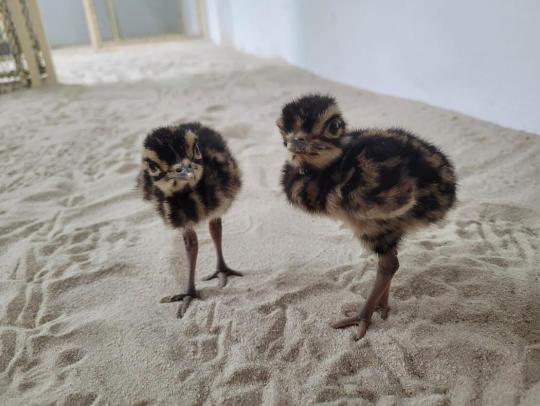
All species of floricans look to dazzle prospective mates with a remarkable courtship display. Standing in high grass, they will leap between 6 and 9 feet off the ground whilst striking a heroic pose that involves tucking their legs up and leaning back.
Hardly flightless, their goal isn’t to take to the wing, but to stay airborne enough to attract the attention of a female, before falling back to the ground and disappearing among the grasses.
Unfortunately, these birds need grasslands to live in, but grasslands in their native range are rapidly being turned into agricultural land by a developing South Asian population.
Leaping into action
The Angkor Centre for Conservation of Biodiversity (ACCB) established the captive colony in 2019. Cambodia has a high degree of threatened biodiversity, with over 400 species listed as Endangered or Vulnerable on the IUCN Red List, and 56 considered Critically Endangered.
The Bengal florican is just one of 30 such species held at the ACCB for future protection. The florican has just one remaining wild population of fewer than 600 individuals among the Tonle Sap Floodplains.
Conservationists from the ACCB work mainly to educate community members, especially Buddhist communities and students, about the plight of these ground-nesting birds.

“By engaging with diverse groups, we hope to bridge the conservation gap across generations,” Christel Griffioen, ACCB’s Country Director, told the IUCN.
These connections with the community have proved vital to the ACCB’s work. During the florican breeding season, the ACCB is notified where and when a wild florican nest is located. Depending on the timing in the season and the placement of the nest, ACCB biologists may choose to leave the eggs alone, but if the conditions aren’t optimal for chick mortality, they will safeguard the eggs, hatch them in their facility, and rear the birds in captivity for eventual reintroduction into the wild.
So far, the 11 surviving birds hatched at ACCB from eggs laid in the wild, along with four wild-hatched birds that have been taken in for one reason or another, are living and developing well.
“A full-time team at ACCB is dedicated to hand-rearing newly hatched chicks until they’re old enough to feed alone. They’re then moved into a facility that mimics their habitat where they remain, with limited to no human contact, safely cocooned in taller grass and soft ceilings that allow the males to practice their mating display,” writes the IUCN, noting that Christel and her team are always trying to transfer what they know about these birds in the wild to their conditions at the facility.
The conservationists hope to form a captive breeding program to further stabilize the animal’s numbers."
-via World at Large, January 10, 2025
#endangered species#biodiversity#ecology#wildlife#wild animals#wildlife photography#bird#conservation#cambodia#asia#good news#hope
655 notes
·
View notes
Text
may 9, 2019 | five years ago today
entertainment weekly released their video of taylor in which she spoke about easter eggs and her favorite ways to leave them
“i love to communicate via easter eggs. i think the best messages are cryptic ones”
1. the first way she leaves easter eggs is through clothing and jewelry
“this is one of my favorite ways to do this”
she specifically recalls painting her nails the color palette of ‘lover’ for the ‘delicate’ vertical video
2. the second way she leaves easter eggs is in set designs for photoshoots and music videos
she said she really started this during the reputation era and the most easter egged video of hers at the time was ‘look what you made me do’
the scene representing the eight beards dressed as tom hiddleston was shown as she was saying this
3. she explained her original form of easter egging was through coded messages in her lyrics and the purpose of leaving them
“it makes people read the lyrics. it makes the album more of an event. easter eggs are a way to expand the experience of seeing something or hearing it”
4. another way she leaves easter eggs are hints in print through interviews and calendars
5. she also uses symbolism as a means to leave easter eggs
one example she gave was the palm trees she posted upon finishing the ‘lover’ album, symbolizing rebirth, new beginnings, and positive energy
#may 9 2019#may 9#2019#entertainment weekly cover#easter eggs#gaylor throwbacks#gaylor#gaylor swift#lgbetty
30 notes
·
View notes
Text
DnP Interview Masterlist
This is a work in progress! If you have any other links, send them to me!
Jan 2025
Shut Up I'm Talking Podcast (video) 26/1/2025 | mirror | add-on
Dec 2024
RNZ (audio) 10/12/2024 | mirror
Radio Adelaide (audio) 10/12/2024 | mirror | mirror
Junkee (article) 6/12/2024
Junkee (video) 6/12/2024
Today Show (video) 5/12/2024 | mirror | mirror
Nov 2024
Buzzfeed (article) 22/11/2024 | mirror | mirror
People (article) 1/11/2024 | mirror
Oct 2024
People (article) 6/10/2024
YourEx (article) 5/10/2024 | mirror | mirror
Master up to 2023 (courtesy of @stillarchivingdnp)
YWGTTN promo master (courtesy of @dailydnp)
May 2024
Dan: Times Radio (video) 11/5/2024
2023
Dan: Anthony Padilla (video) 17/1/2023
Dan: DNA Magazine (article) 9/1/2023
2022
Dan: Santa Barbara Independent (article) 30/11/2022
Dan: Gay Times (article) 11/11/2022
Dan: heatworld (video) 1/11/2022
Dan: Hits Radio (video) 21/10/2022
Dan: The Star (article) 5/10/2022
Dan: Buzz (article) 12/9/2022
Dan: Manc Union (article) 18/8/2022
Dan: Square Mile (article) 29/7/2022
Dan: metro.co.uk (article) 9/6/2022
2021
Dan: How To Academy (video) 1/7/2021
Dan: 1883 (article) 30/6/2021
Dan: RNZ Nine to Noon (audio) 30/6/2021
Dan: GQ (article) 30/5/2021
Dan: Waterstones (video) 24/5/2021
Dan: Amazon (article) 12/5/2021
2020
Dan: Guardian (article) 26/12/2020 | mirror
Dan: Pink News (article) 4/12/2020
Dan: Attitude (article) 7/10/2020 | mirror | mirror | preview
Dan: ITV Britain Get Talking (audio) 7/10/2020 | mirror
Phil: Evening Standard (article) 3/2/2020
2019
Dan: BBC (video) 5/9/2019 | mirror
2018
HMV (article) 10/12/2018
Toy News (article) 5/3/2018
2017
Edinburgh TV Festival (video) 24/8/2017
2016
Penguin Platform (video) 10/11/2016
Stand Up to Cancer (video) 15/10/2016
Variety (article) 4/10/2016
The Big Wakeup Call (audio) 21/4/2016
2015
Star Sessions (video) 20/11/2025
Huffington Post (video) 19/11/2025
WOCA Radio (audio) 17/11/2015
Sunday Times (article) 8/11/2015
SugarScape, Pt. 2 (video) 11/10/2015
SugarScape (video) 9/10/2015
2014
Rock Forever Magazine (video) 19/4/2014
2013
The Independent (article) 1/6/2013
The 4:01 Show (video) 17/3/2013
Dan: Elision (article) 13/1/2013
2012
Dan: Huffington Post (article) 26/11/2012
#dan and phil#phan#bookmark#daniel howell#amazingphil#ok i think this is all we got so far? i can't remember or find anything else from this year
499 notes
·
View notes
Text








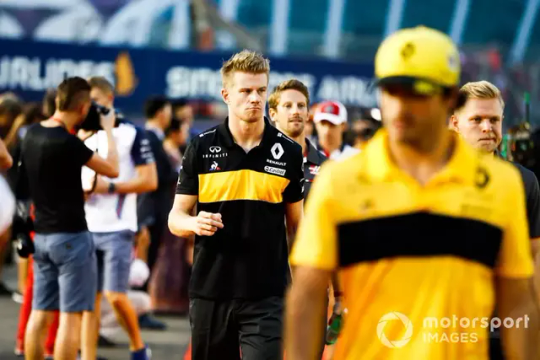





















1. July 20-22, 2018 - German Grand Prix
2. September 13-16, 2018 - Singapore Grand Prix
3. September 20-30, 2018 - Russian Grand Prix
4. October 19-21, 2018 - United States Grand Prix
5. November 23-25, 2018 - Abu Dhabi Grand Prix
6. December 5, 2018 - Autosport Awards, 2018
7. March 29-31, 2019 - Bahrain Grand Prix
8. April 13, 2019 - Chinese Grand Prix
9. May 20, 2019 - Treiber Football Match, Monaco
In honor of their last week as teammates, here's some of them before they were teammates (a shorter pt 2 here)
#charles leclerc#carlos sainz#charlos#abu dhabi gp 2024#hopefully this is all right#it's comforting to me that they were friendly before being teammates#and will likely still be close if not closer after
474 notes
·
View notes
Text

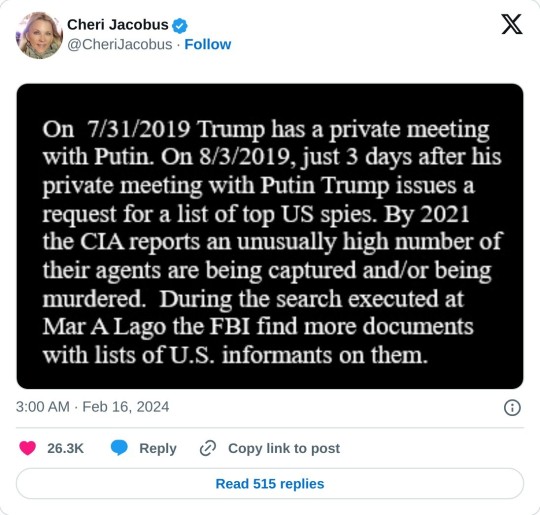
On 7/31/2019 Trump has a private meeting with Putin. On 8/3/2019, just 3 days after his private meeting with Putin, Trump issues a request for a list of top US spies. By 2021 the CIA reports an unusually high number of their agents are being captured and/or being murdered. During the search executed at Mar A Lago the FBI find more documents with lists of U.S. informants on them.
A Timeline
• FBI wiretapped Russian gambling ring headquartered at Trump Tower for two years - March 21, 2017
• Trump revealed highly classified information to Russian foreign minister and ambassador - May 15, 2017
• Trump, Putin Meet For 2 Hours In Helsinki - July 16, 2018
• Rand Paul Goes To Russia And Delivers Letter For Trump, Marking Our Era Of Irony - August 9, 2018
• Following the Money: Trump and Russia-Linked Transactions From the Campaign to the Presidential Inauguration - December 17, 2018
• The US extracted a top spy from Russia after Trump revealed classified information to the Russians in an Oval Office meeting - September 10, 2019
• Trump’s Loose Lips Force US to Extract Spy From Kremlin - September 10, 2019
• Was Mar-a-Lago Trespasser a Tourist or a Spy? A Judge Said Her Story Didn’t Hold Up. - November 25, 2019
• Trump downplays massive cyber hack on government after Pompeo links attack to Russia - December 19, 2020
• Russia has been cultivating Trump as an asset for 40 years, former KGB spy says - January 29, 2021
• There was Trump-Russia collusion — and Trump pardoned the colluder - April 17, 2021
• Longtime GOP operatives charged with funneling Russian national’s money to Trump, RNC - September 20, 2021
• Captured, Killed or Compromised: C.I.A. Admits to Losing Dozens of Informants - October 5, 2021
• Files Seized From Trump Are Part of Espionage Act Inquiry - August 12, 2022
• Ex-Clinton aide implies 'President of France' file found at Trump's home during Mar-a-Lago raid could be valuable to Putin as 'kompromat' - August 13, 2022
• Inventing Anna: The tale of a fake heiress, Mar-a-Lago, and an FBI investigation - August 22, 2022
• Russians used a US firm to funnel funds to GOP in 2018. Dems say the FEC let them get away with it - October 30, 2022
• Trump makes shocking comments about trusting Putin over US 'intelligence lowlifes' - January 31, 2023
• Russia's Prigozhin admits links to what US says was election meddling troll farm - February 14, 2023
• GOP operative sentenced to 18 months for funneling Russian money to Trump- February 17, 2023
• Trump allegedly discussed US nuclear subs with foreign national after leaving White House: Sources - October 5, 2023
• 'So appalled': What witnesses told special counsel about Trump's handling of classified info while still president - April 24, 2024
🤔🤔🤔
#us politics#news#republicans#conservatives#donald trump#gop#trump administration#classified documents#cheri jacobus#2024#twitter#tweet#russia#vladimir putin#spies#foreign intelligence#espionage act#cia#my thoughts
866 notes
·
View notes
Text
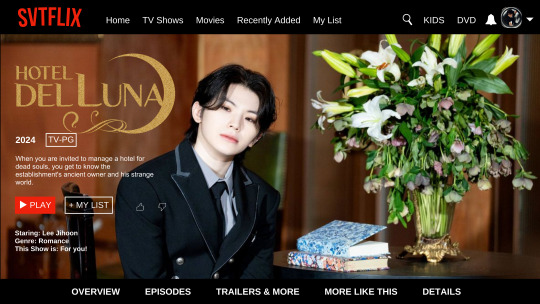
📺 now watching: "hotel del luna" (jihoon x reader)
part of my svtflix milestone event. warnings: cussing/swearing, mentions of death. more content under the cut. enjoy watching!

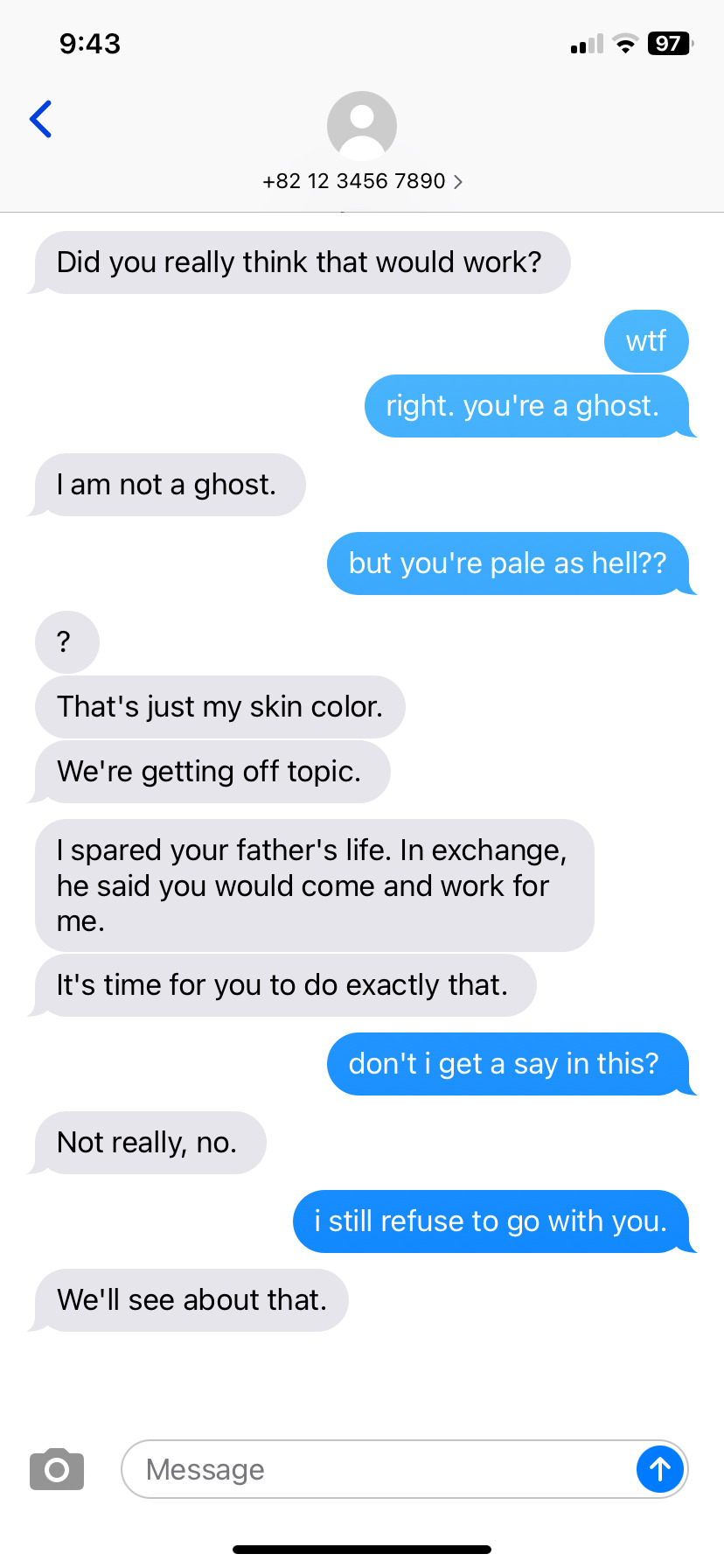
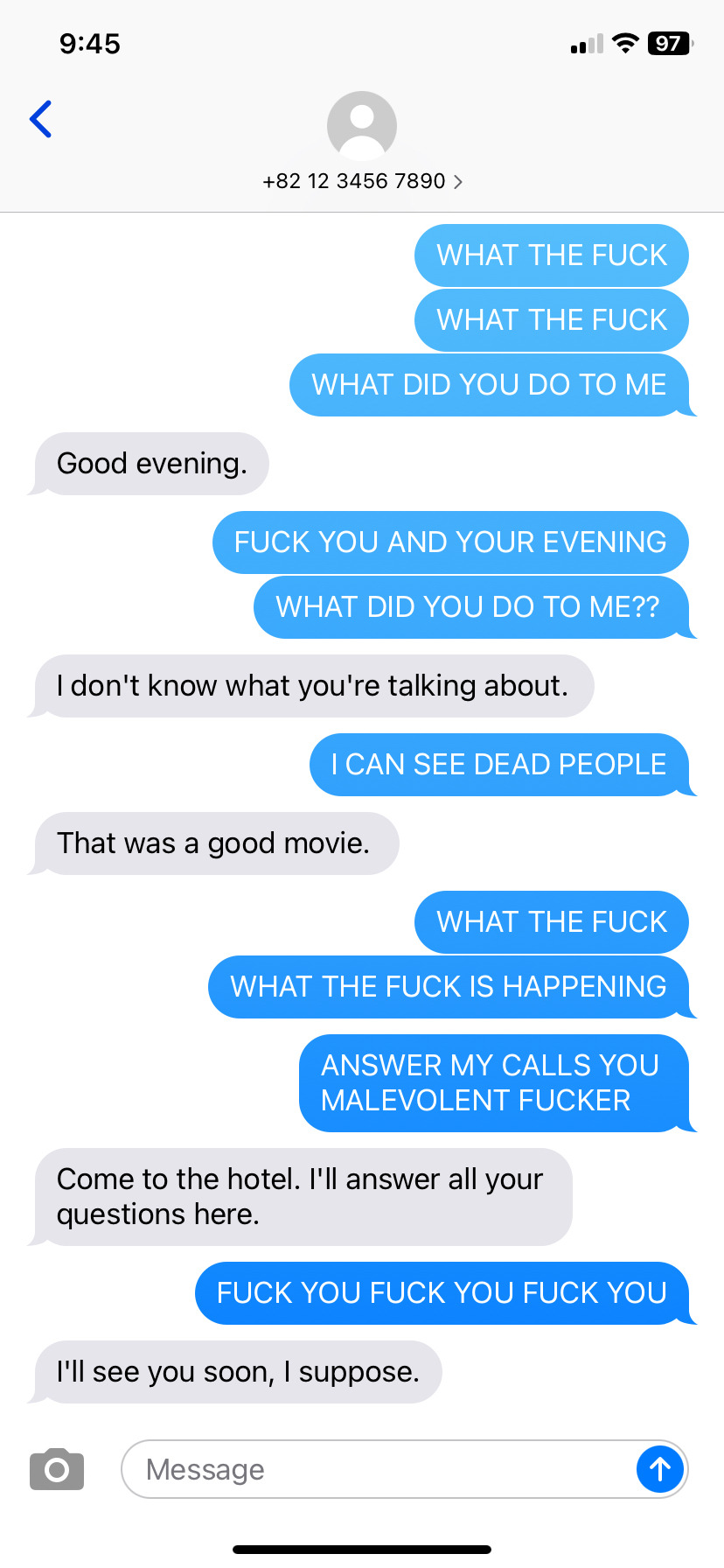
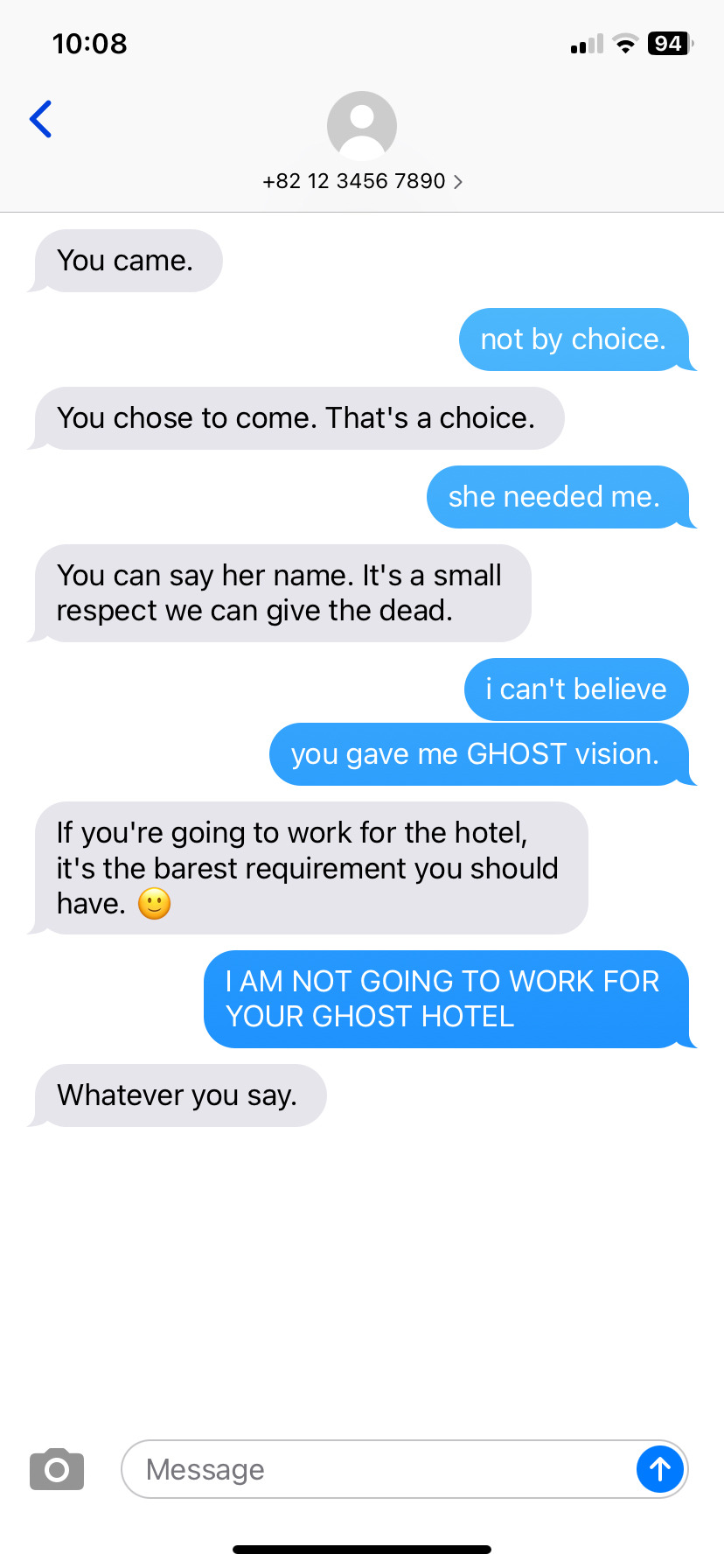

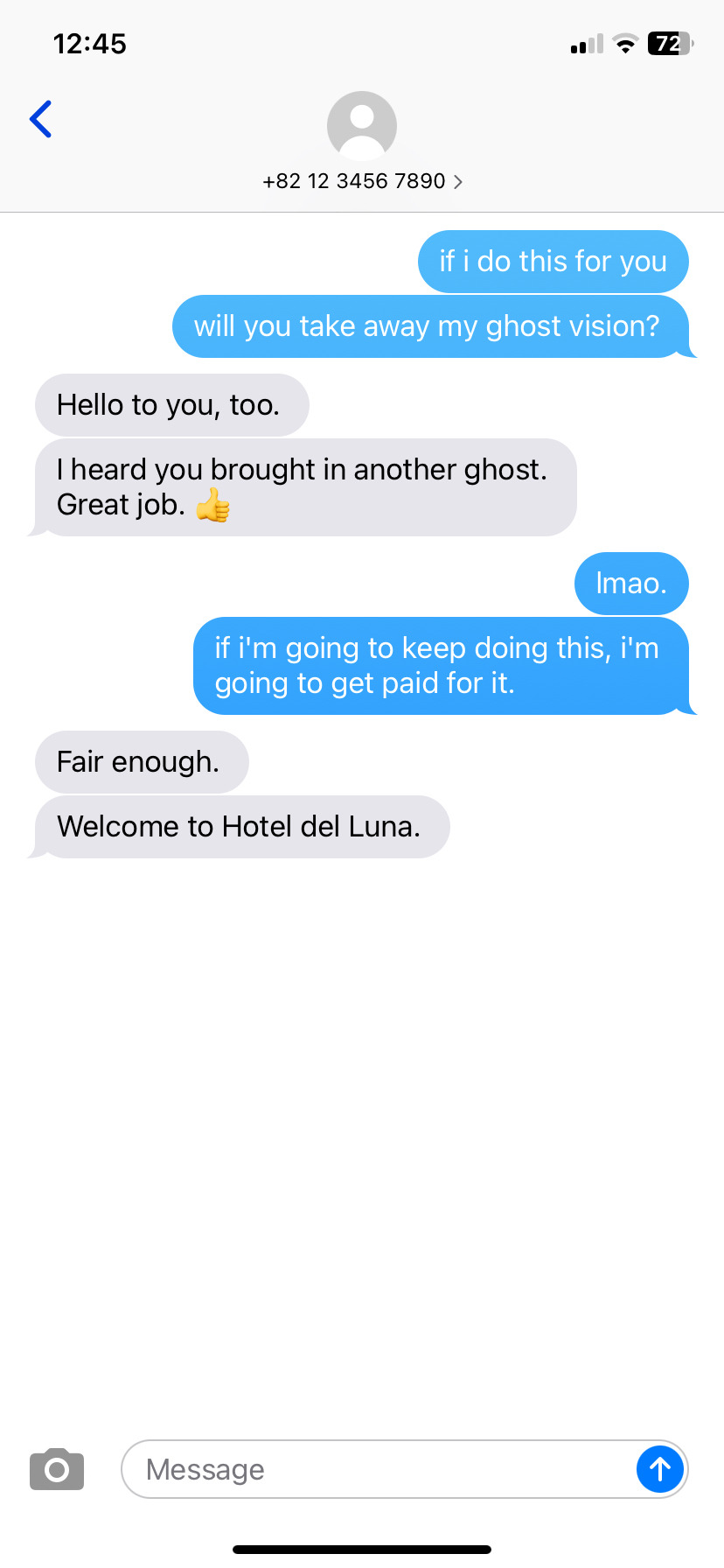


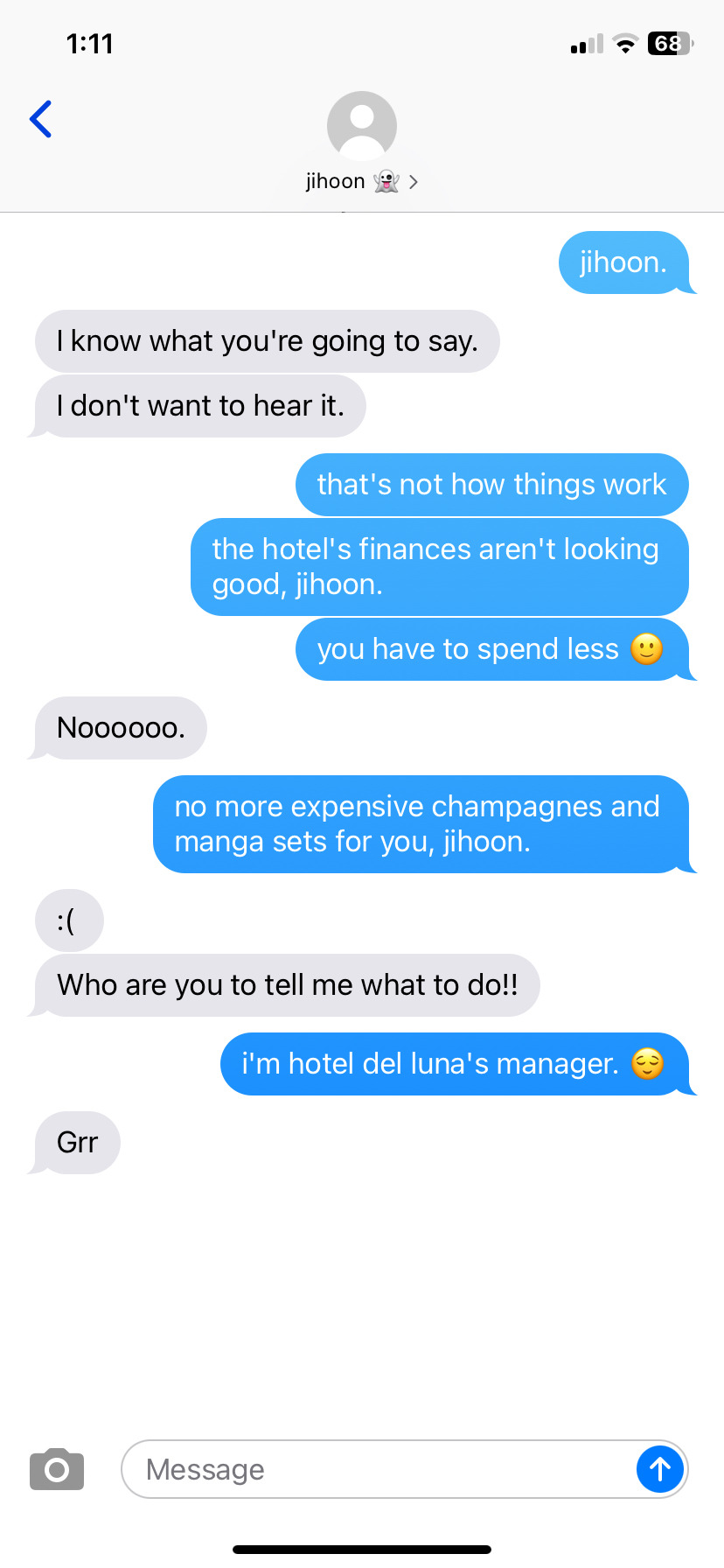
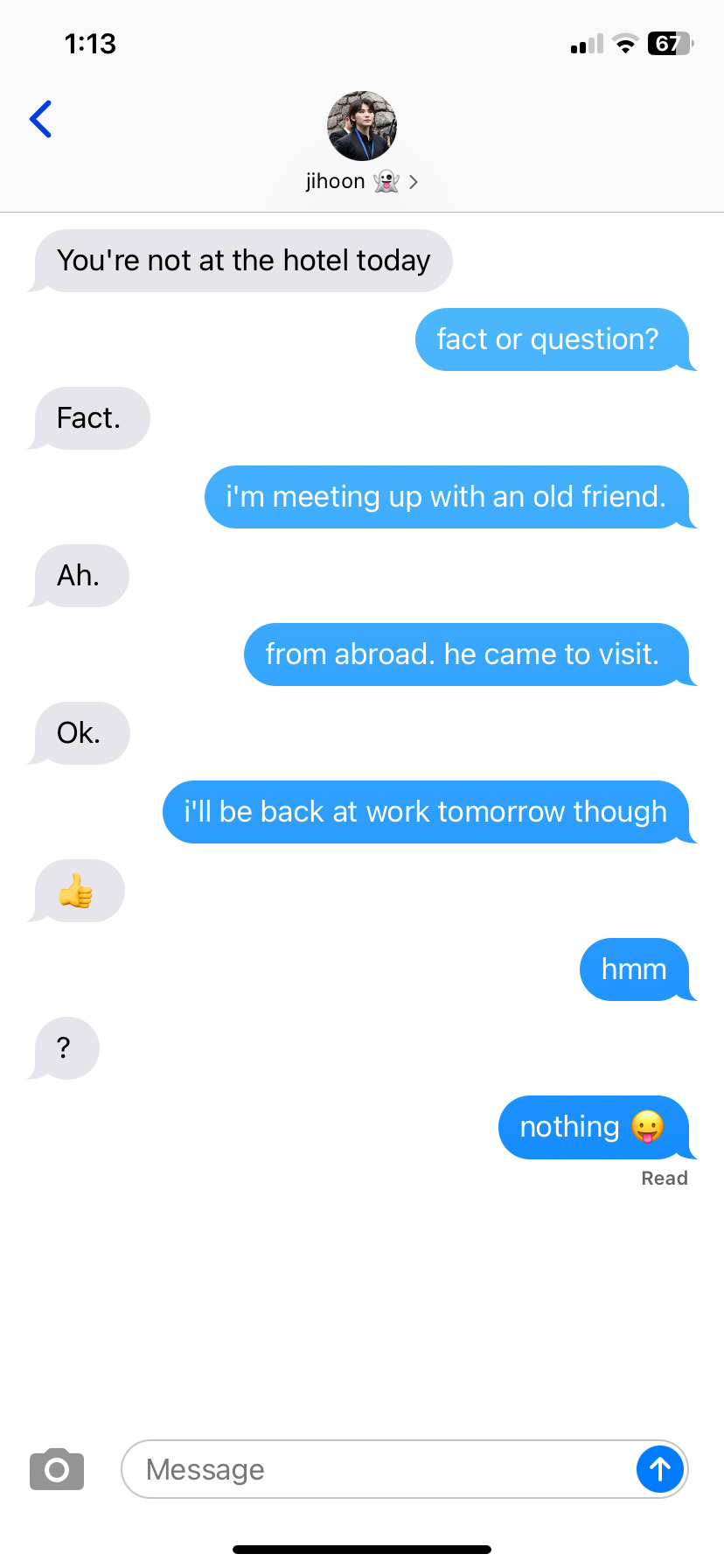
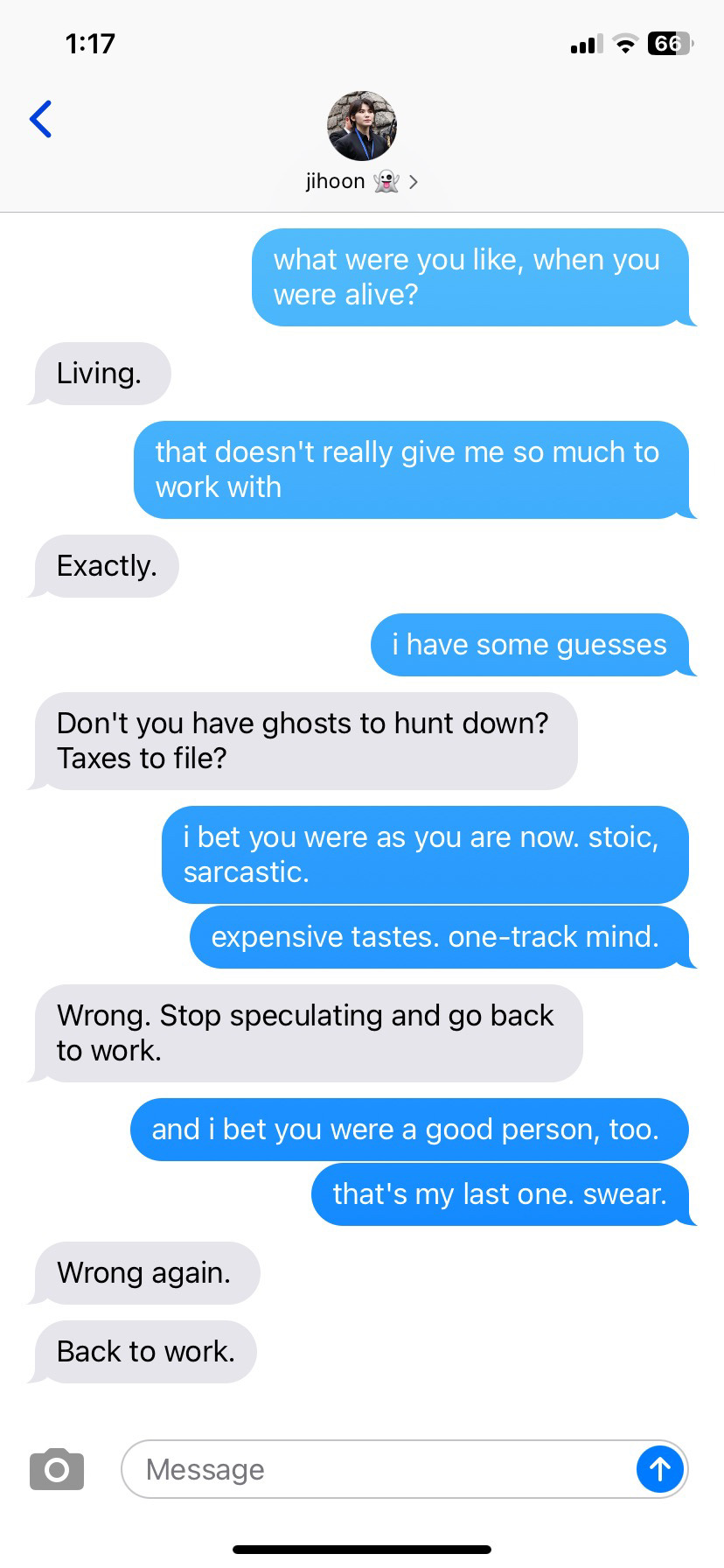
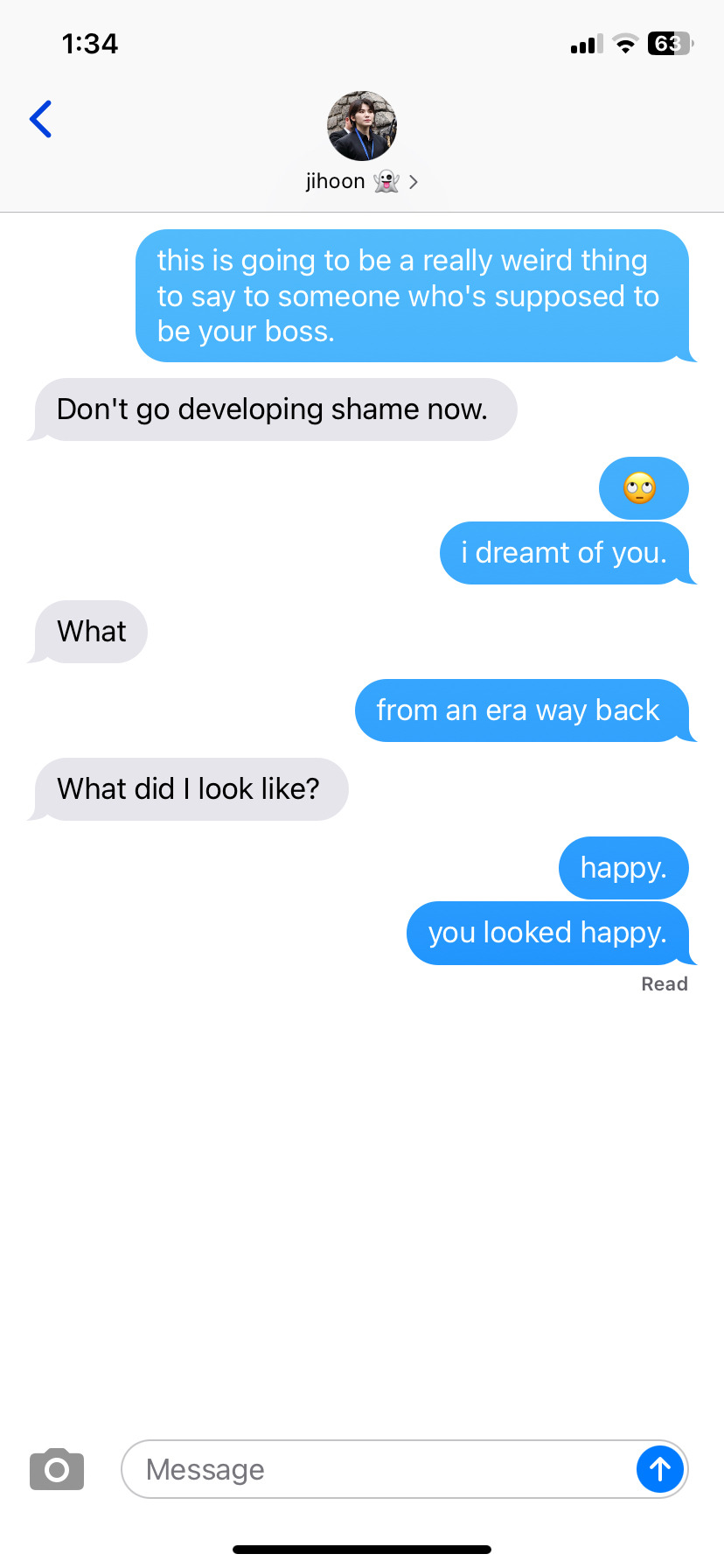


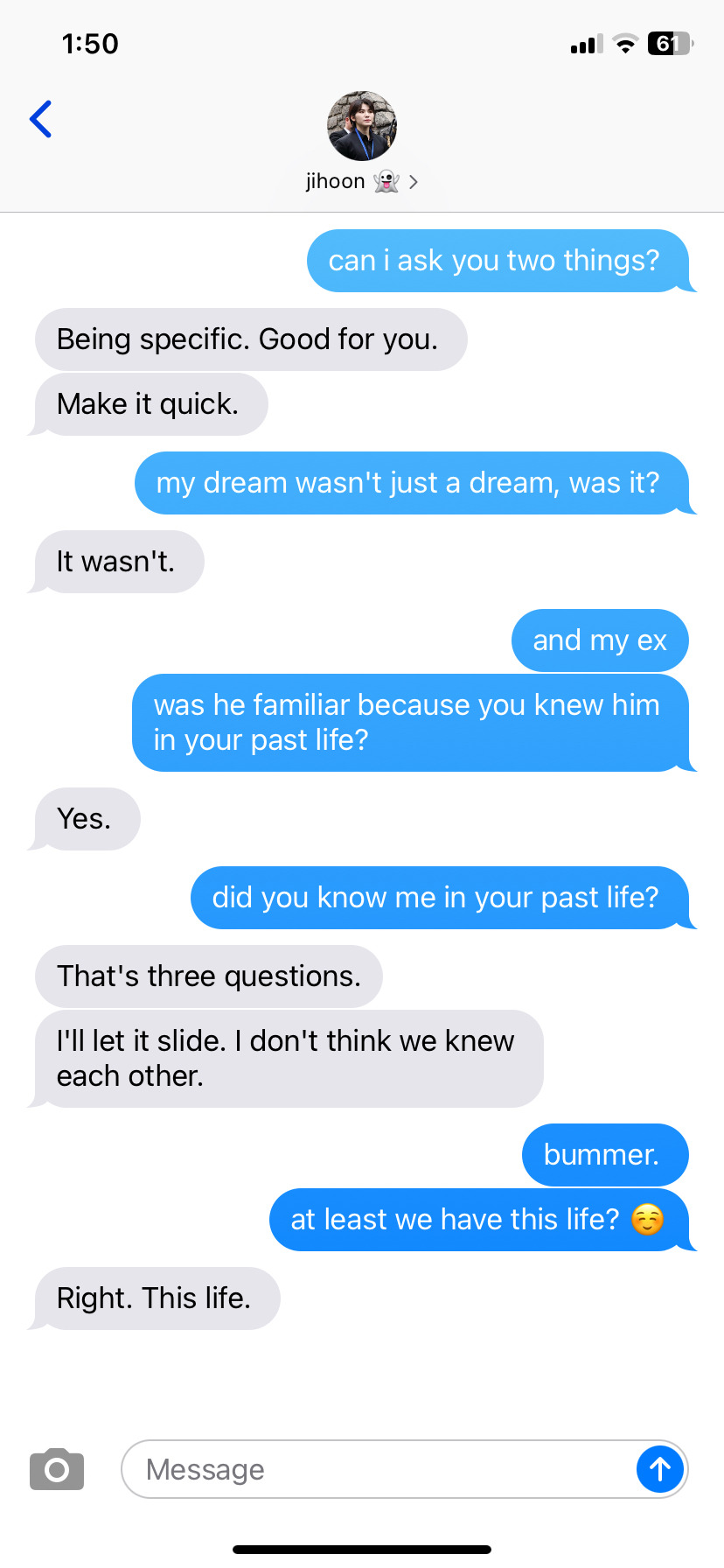

hotel del luna's guestbook, as managed by lee jihoon.
Name: Han Seung-woo Check-in date: August 17, 2019 Reason for stay: Seung-woo was a street artist who passed away in a tragic car accident at the height of his career. He stayed at hotel, haunted by the regret of never completing his masterpiece mural, which he planned to dedicate to his late mother. Reason for leaving: The hotel manager tracked down Seung-woo's original sketches and helped arrange for a modern artist to complete his mural at a public plaza. Witnessing his vision come to life brought him peace. Check-out date: January 11, 2024
Name: Choi Min-ji Check-in date: May 4, 1997 Reason for stay: Min-ji was a nurse who sacrificed herself to save patients during a hospital fire. She lingered at Hotel del Luna because she couldn’t forgive herself for leaving her younger brother behind, feeling she hadn’t done enough to care for him. Reason for leaving: Decades letter, her brother passed away; the manager brought him to the hotel. During their reunion, he reassured Min-ji that her sacrifice inspired him to become a doctor and save lives, fulfilling her legacy. They crossed into the afterlife together. Check-out date: October 9, 2024
Name: Kang Mi-young Position in Hotel del Luna: Receptionist Check-in date: July 8, 1975 Reason for stay: Mi-young was a renowned opera singer who lost her voice in life. She became the hotel receptionist to welcome guests with warmth and kindness, making up for the bitterness she had shown in her final days. Reason for leaving: A guest, who was a devoted fan of her opera performances, recognized her and reminded her of how much her art had inspired others. This helped her regain a sense of purpose and release her regret. Check-out date: December 31, 2024
Name: Park Jin-ho Position: Concierge Check-in date: January 12, 1843 Reason for stay: Jin-ho was the very first staff member of Hotel del Luna. He accepted the role of concierge after passing away as a penniless merchant who regretted his life of greed and failed relationships. He hoped to redeem himself by helping guests find closure. Reason for leaving: After serving at the hotel for over 180 years, Jin-ho finally forgave himself when the manager thanked him for teaching them the value of love and selflessness— something he had yearned to learn in his own life. Check-out date: June 8, 2024
Name: Lee Jihoon Position in Hotel del Luna: Proprietor Check-in date: August 23, 1290 Reason for stay: Jihoon lived over a millennium ago during the Goguryeo era. He was the leader of a band of thieves and was devastated after the massacre of his loved ones; namely, his bandit group and closest friend. Fueled by vengeance, Jihoon killed various people in his fury. Deity Ma Go punished him for his sins by bounding him to the Hotel del Luna. He was warned that he would only be unshackled from the hotel once he is able to replace his fury and grief with remorse and love. Reason for leaving: You N/A Check-out date: N/A

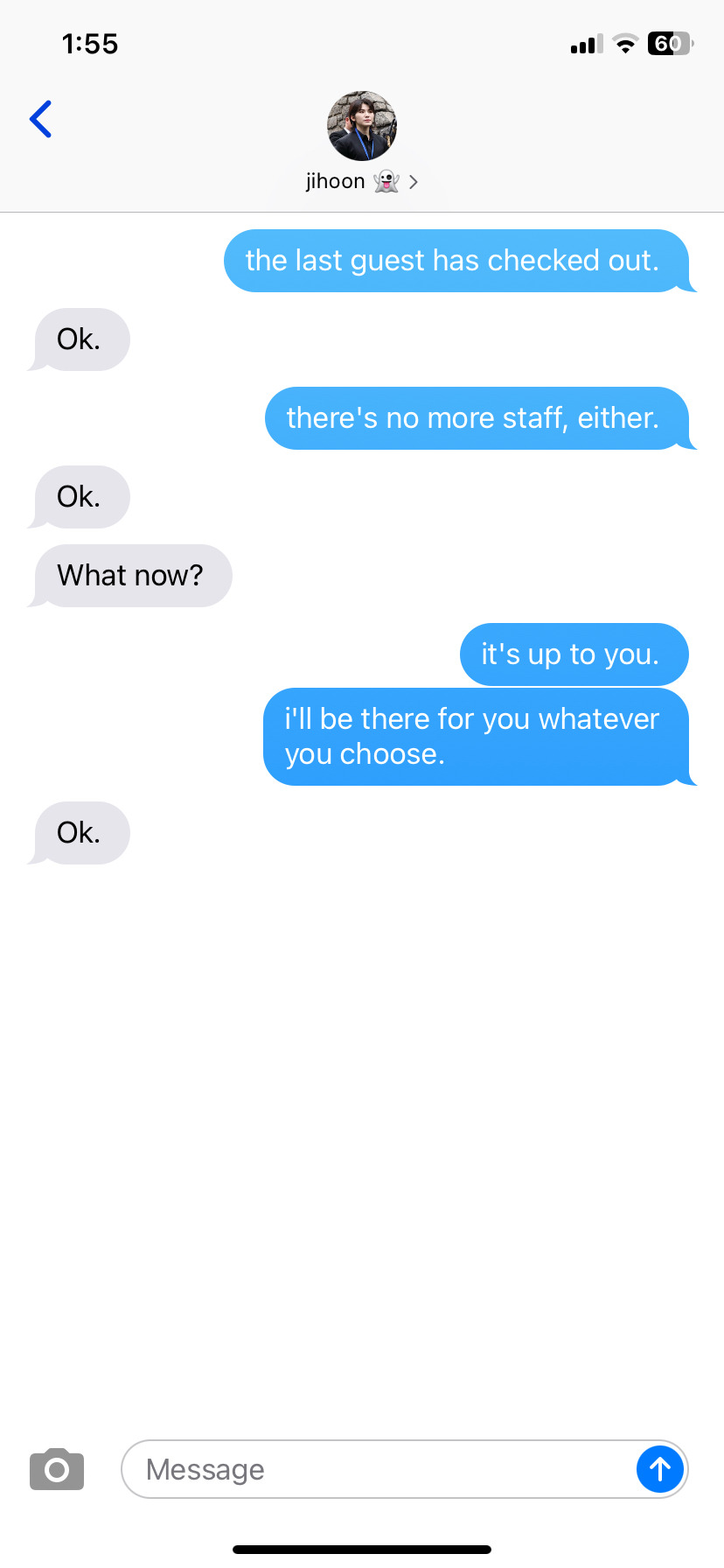
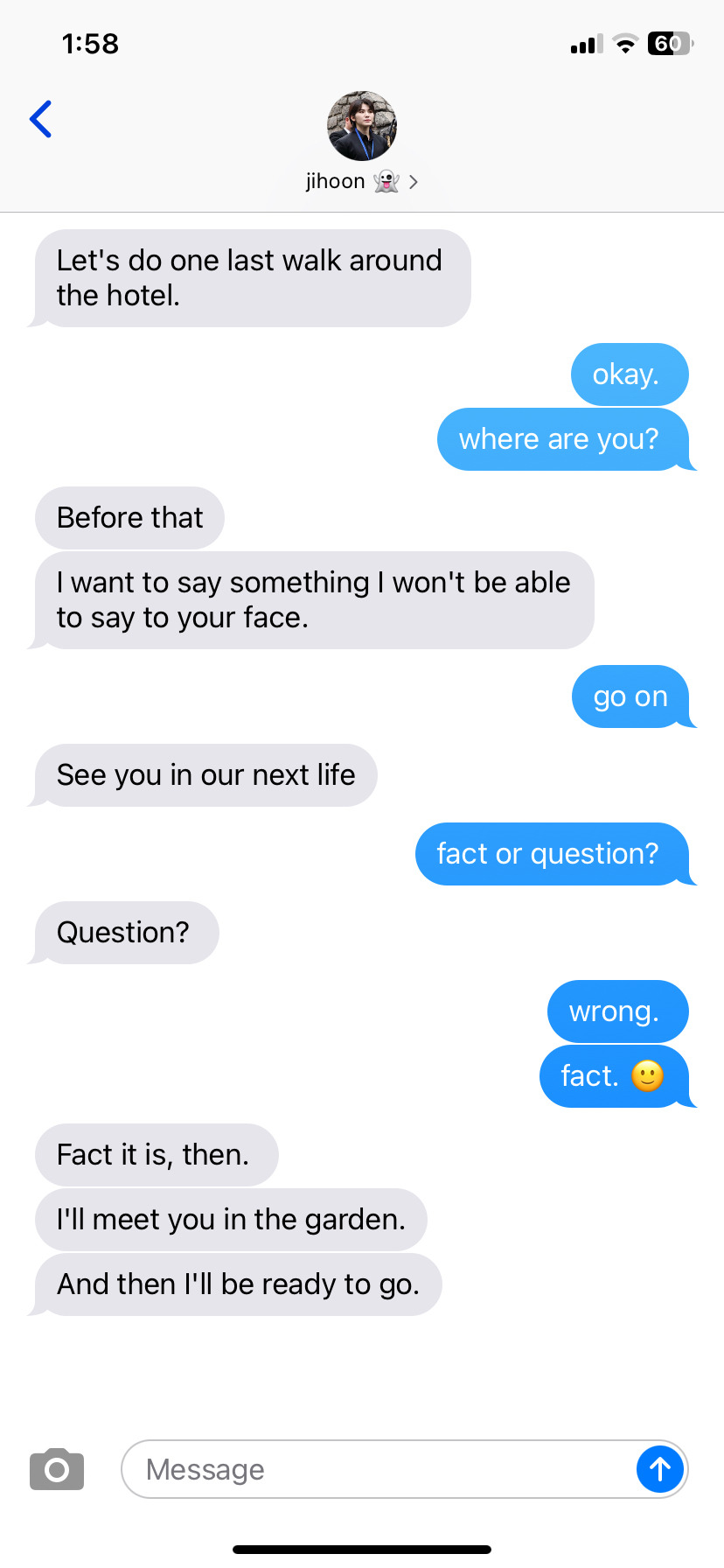
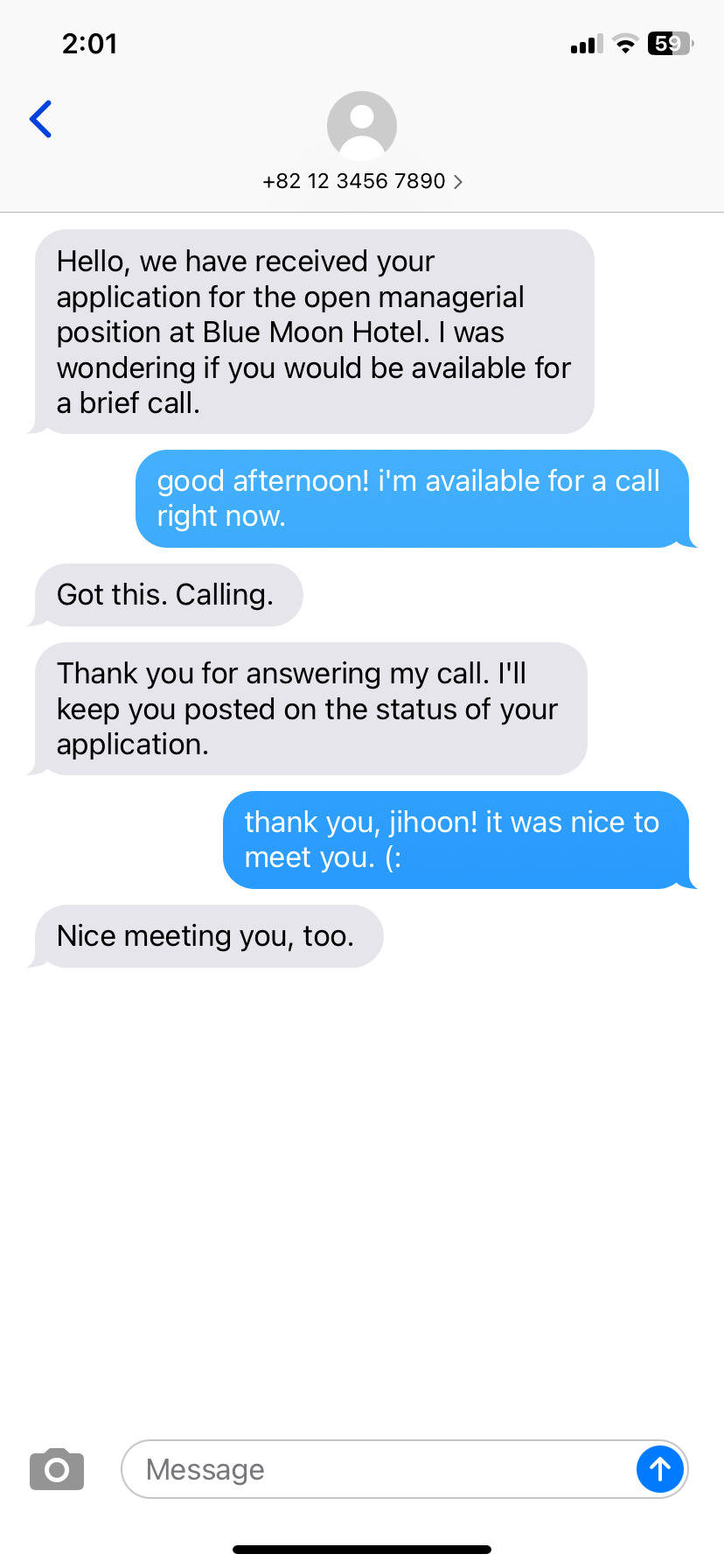

› scroll through all my work ദ്ദി ˉ͈̀꒳ˉ͈́ )✧ ᶻ 𝗓 𐰁 .ᐟ my masterlist | @xinganhao
#woozi x reader#jihoon x reader#lee jihoon x reader#woozi imagines#woozi smau#jihoon smau#jihoon imagines#svt x reader#seventeen x reader#svt imagines#seventeen imagines#svt smau#seventeen smau#── ᵎᵎ ✦ mine#── ᵎᵎ ✦ milestone event: svtflix#[ this made me unexpectedly sadder than it should have lol. oh lee jihoon the man that u are ]
358 notes
·
View notes
Text

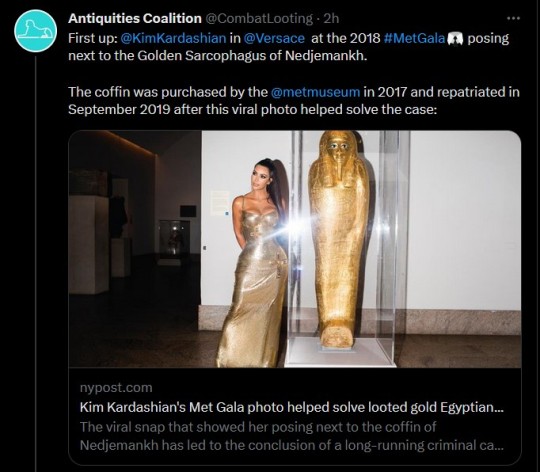
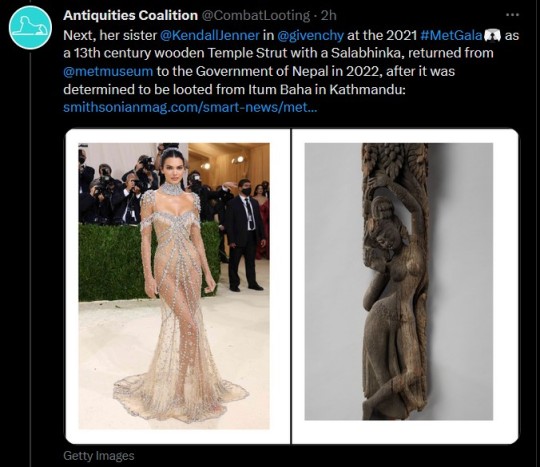
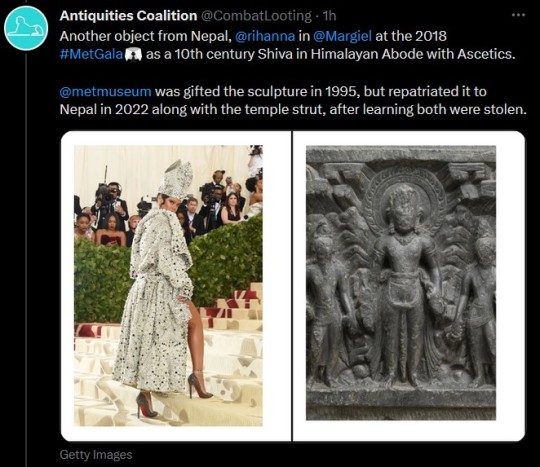

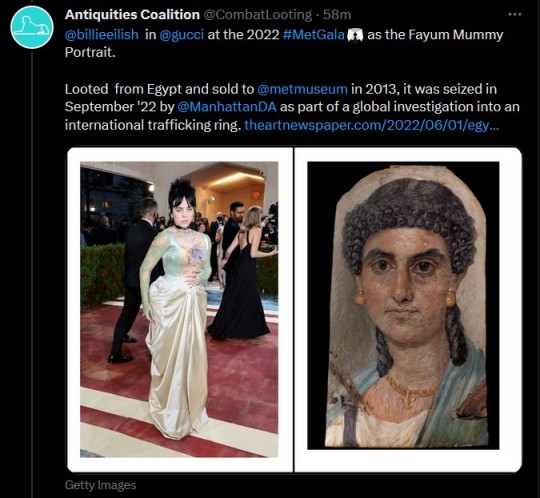
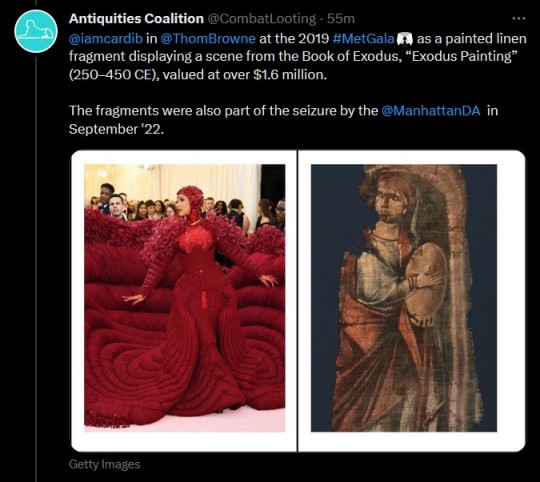
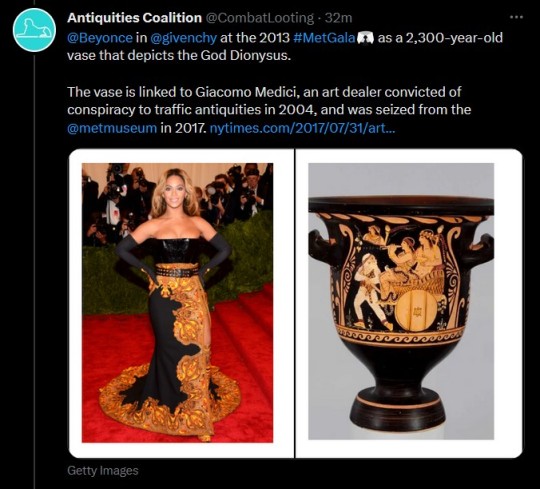
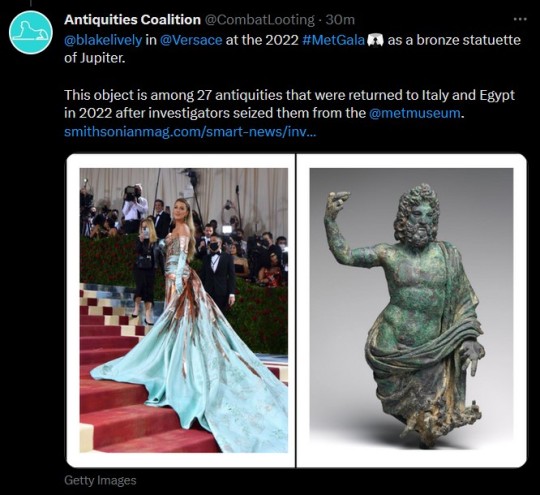
Looks vs. Loot at the Metropolitan Museum of Art by The Antiquities Coalition (@/CombatLooting) on Twitter
Transcription below the cut
1: The #MetGala may be "fashion's biggest night," but tonight's event hides some dark truths at @/metmuseum...including a long history of looted antiquities. To spotlight some of the contested objects from the Met's collection, we are featuring #MetGala vs. Loot [THREAD]
2. First up: @/KimKardashian in @/Versace at the 2018 #MetGala posing next to the Golden Sarcophagus of Nedjemankh. The coffin was purchased by @/metmuseum in 2017 and repatriated in 2019 after this viral photo helped solve the case. (link)
3. Next, her sister @/KendallJenner in @/givenchy at the 2021 #MetGala as the 13th century wooden Temple Strut with Salabhinka, returned from @/metmuseum to the Government of Nepal in 2022, after it was determined to be looked from Itum Baha in Kathmandu. (link)
4. Another object from Nepal, @/rihanna in @/Margiel at the 2018 #MetGala as a 10th century Shiva in Himalayan Adobe with Ascetics. @/metmuseum was gifted the sculpture in 1995, but repatriated it to Nepal in 2022 along with the temple strut, after learning both were stolen.
5. Dakota Johnson in @/gucci at the 2022 #MetGala as a terracotta kylix (c. 470 bCE). This piece, valued at $1.5 million, was seized from the @/metmuseum in July 2022 after being linked to Italian antiquities trafficker Gianfranco Becchina. (link)
6. @/billieeilish in @/gucci at the 2022 #MetGala as the Fayum Mummy Portrait. Looted from Egypt and sold to @/metmuseum in 2013, it was seized in September '22 by @/ManhattanDA as part of a global investigation into an international trafficking ring. (link)
7. @/iamcardib in @/ThomeBrowne at the 2019 #MetGala as a painted linen fragment displaying a scene from the Book of Exodus, 'Exodus Painting" (250-450 CE), valued at over $1.6 million. The fragments were also part of the seizure by the @/ManhattanDA in September '22.
8. @/Beyonce in @/givenchy at the 2013 #MetGala as a 2,300-year-old vase that depicts the god Dionysus. The vase is linked to Giacomo Medici, an art dealer convicted of conspiracy to traffic antiquities in 2004, and was seized from the @/metmuseum in 2017. (link)
9. @/blakelively in @/Versace at the 2022 #MetGala as a bronze statuette of Jupiter. This object is among 27 antiquities that were returned to Italy and Egypt in 2022 after investigators seized them from the @/metmuseum. (link)
5K notes
·
View notes
Text
An ongoing Daniel Ricciardo video collection ❤️🍯🦡☀️
adding links to vimeo and youtube finds (under the cut, so it'll update reblogs as I add more links over time!)
hello!! This is definitely not a comprehensive list, mostly filing under things that are just new to me as a more recent fan! it's cool when I stumble upon a vid I haven't seen or one I recognize from a gif set! so I'm adding them in a list of links here in case anyone else is curious ❤️ some are like 30 second commercial spots & others are longer interviews, most so far from 2014-2020 🎥🎤✨
okay allons-y!!
Sourced from Vimeo
not chronologically organized (yet!) so I've just added the upload date atm for a date approximation; have yet to look into all the uploading accounts, too, so there is definitely way more out there to see!
📍Update 01-01-2025:
Btw if you click a link in the tumblr app and it shows a tumblr page saying "There's nothing here" sadly many of the vimeo links are not redirecting correctly atm 😭
the videos are still up and available (thankfully!! and they can be found by searching the titles on vimeo [which are listed for each vid before the upload date part below]) but!! I will be making like a Google doc with all the links, since tumblr insists on adding this redirect bologna and I'm not tech savvy enough to know why its not working hehe 🙃 I'll be back this weekend with a fix and the new link list!
lastly here's the link for DR's brand vimeo which also has the overall site search option at the top for easy access 🔍 not linked but copy-and-pastable into Google or Safari etc: https://vimeo.com/user50821531
thanks y'all!! ❤️
update 01-05-2025 I'm sorry y'all!! I have been fighting a fever all weekend 😭 so I have yet to compile everything, but the Google doc with all the working links will be here asap!! ❤️

definitely starting with the dozens of videos on DR's official brand Vimeo (which has the delightful Sunday Night Flights series of casual post-race recaps) link
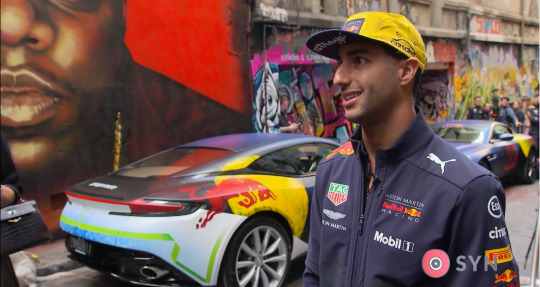
Daniel Ricciardo and Max Verstappen paint Aston Martins in Hosier Lane - Uploaded on Mar 21, 2018 - link

Daniel Ricciardo - T Magazine Aus BTS spot - Uploaded on Jan 14, 2023 - link

Ricciardo, favorito para el GP de Singapur - Uploaded on Oct 25, 2016 - link
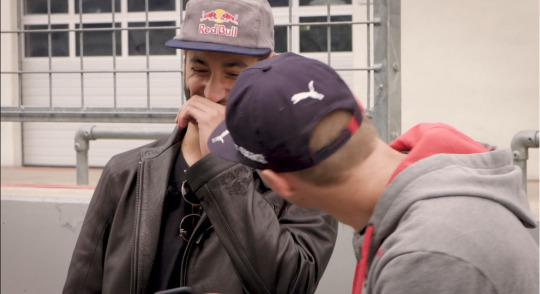
Red Bull - Camper Race BEHIND THE SCENES | Max Verstappen und Daniel Ricciardo - Uploaded on May 29, 2017 - link
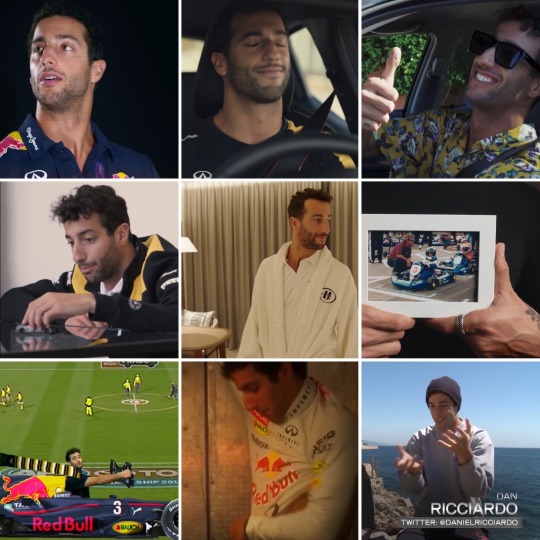
Red Bull InFrames - Singapore GP with Daniel Ricciardo - Uploaded on Oct 25, 2017 - link
Daniel Ricciardo drives Renault Clio - Uploaded on Jul 24, 2014 - link (ah the image in the collage above is for the other Clio commercial linked below and vice versa!! I got them mixed up when adding screenshots hehe. Pobody's nerfect)
Daniel Ricciardo | Race Service (parallel parking with some slightly haunting editing) - Uploaded on May 22, 2022 - link
Season Break - Daniel Ricciardo - Uploaded on Jan 30, 2020 - link
Daniel Ricciardo x Hilton - Uploaded on Feb 7, 2023 - link
Optus TVC Daniel Ricciardo - Uploaded on Dec 17, 2024 - link
Fox Sports - I Am Daniel Ricciardo (bananas editing /positive) - Uploaded on Apr 9, 2017 - link
ESPN AUSSIES ABROAD: DANIEL RICCIARDO - LIFE IN THE FAST LANE Opener - Uploaded on Apr 21, 2016 (I have yet to watch the full documentary!) - link
ESPN AUSSIES ABROAD- DANIEL RICCIARDO - LIFE IN THE FAST LANE Preview 2 - Uploaded on Apr 21, 2016 - link

Daniel Ricciardo: Uncut (😳🥴 sorry mind in the gutter, this is a longer interview tho!) - Uploaded on Sep 17, 2017 - link
Daniel Ricciardo Feature - Uploaded on Mar 28, 2018 - link
Renault Clio I Ricciardo I Augusto Gimenez Zapiola - Uploaded on Sep 3, 2020 - link
Sky Sports Ident - F1 - Ricciardo - Uploaded on Jan 5, 2018 - link
PIRELLI: DANIEL RICCIARDO P ZERO WORLD - Uploaded on Aug 12, 2016 - link
C4F1 Daniel Ricciardo Interview Australia 2019 - Uploaded on Mar 20, 2019 - link
Daniel Ricciardo_comp_1005 - Uploaded on Dec 11, 2017 - link
Daniel Ricciardo x Artura - Uploaded on Feb 10, 2021 - link
Daniel Ricciardo drives the Triple Eight Project Sandman V8 Supercar - Uploaded on Mar 16, 2016 - link

Red Bull Racing x PUMA USGP Launch at Austin Speed Shop - Uploaded on Mar 7, 2017 - link
TAG Heuer Aston Martin Red Bull Racing 2018 Global Commercial - Uploaded on Jul 12, 2019 - link
Red Bull : One day in the life of Daniel Ricciardo - Uploaded on Apr 15, 2016 - link
Carsales // Celebrity Drive with Daniel Ricciardo - Uploaded on Aug 1, 2023 - link
On_set_with_Daniel_Ricciardo.mov - Uploaded on Nov 22, 2021 - link
Castrol EDGE Daniel Ricciardo Live on The Edge - Uploaded on Jun 4, 2020 - link
Aston Martin Racing - Daniel Ricciardo vs Darren Turner - Uploaded on Dec 17, 2021 - link
Red Bull Racing Daniel Ricciardo Photoshoot - Behind the scenes - Uploaded on Sep 16, 2020 - link
Dan Ricciardo and Alissa Smith - Silverstone 2018 Interview - Uploaded on Apr 14, 2019 - link
YouTube
omg I have yet to properly dive into YouTube! probs this section will just be as I come across things (Vimeo is much more manageable for perusing)

[2017 F1]日本GP ダニエル・リカルド&マックス・フェルスタッペン トークショー Daniel Ricciardo & Max Verstappen's talk show - 10-08-2017 - link
Added 01-01-2025 - Daniel Ricciardo on Malaysian GP - 09-27-2017 - link
Added 01-02-2025 - Q & A with Tonio Liuzzi and Daniel Ricciardo - 08-31-2011 - link
Added 01-05-2025 - Trackwalk with Daniel Ricciardo, Korea - 10-17-2011 - link
more to come soon!! ❤️ thank you for stopping by!
159 notes
·
View notes
Text
The return of the hostages from Hamas captivity is of the utmost importance to Israel.
I thought it might be helpful for some of you to hear just a bit more about certain individuals that Israel is releasing in order for that to happen. The sacrifice being made.
A thread:
1) Mohammad Abu Warda, responsible for 2 bus bombings in the 90s which murdered 46 people.
He made it clear at his trial that he would never stop murdering until Israel was destroyed. He was given multiple life sentences.
Now he'll be freed.

2) Arafat Irfaiya. In 2019 he raped Ori Ansbacher, a 19-year old, and stabbed her to death. He was sentenced to life in prison, plus 20 years.
Now he'll be freed, and no doubt treated as a hero.

3) Zakaria Zubeidi, former Jenin commander of the Al-Aqsa Martyrs Brigade. Responsible for the 2002 terror attack in Beit Shean in which 6 were murdered. In 2019 he was charged with shooting attacks on civilian buses.
There will be widespread rejoincing in Jenin when he returns.

4) Bilal Abu Ghanem. In 2015 he and a fellow terrorist boarded a bus and began shooting and stabbing passengers. Three died, and dozens were wounded.
He received 3 consecutive life sentences.
Now he'll be freed. Here are two of the people in their 70s who he murdered.


5) Wael Qassem and Wissam Abbasi, leaders of the Hamas-affiliated Silwan cell. Responsible for the carrying out of multiple bombings in the Second Intifada, which killed dozens (one of these bombings, at the Cafeteria at Hebrew University in 2002, pictured).
Now to be set free.

6) Ahmed Barghouti, relative & close associate of Marwan Barghouti.
Ahmed is responsible for a number of terror attacks, including a notorious mass-shooting in 2002 at a reception hall in Hadera (pictured) where people were celebrating a Bat Mitzvah.
Now to be freed.

7) Mahmoud Atallah. Given a life sentence for murdering a Palestinian woman who was accused of collaborating with Israel. More recently, manage to sexually assault and rape female prison guards.
Now to be freed.
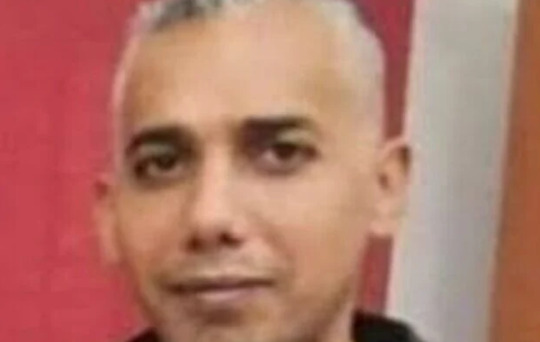
8) Ashraf Zughayer. Hamas leader accused of involvement in the 2002 bus bombing on Allenby Street in Tel Aviv, which killed 6 and injured dozens.
Now he'll go free.

9) Tabet Mardawi of Palestinian Islamic Jihad. Responsible for multiple terror attacks, including suicide bombings at stations in Binyamina (pictured) & Afula, a bombing at a bombing at a restaurant in Kiryat Motzkin (pictured).
Now he'll go free.


10) Nassim Zaatari. Received multiple life terms for his role in a 2003 terror attack when a suicide bomber detonated a five-kilogram device packed with ball bearings on a crowded bus in Jerusalem. 23 murdered, including 7 children.
Now he'll be free.

11) Ahmad Obeid, was sentenced to seven life terms for his role in sending out the suicide bomber responsible for the 2004 Café Hillel terror attack in Jerusalem.
Now he'll be free.

12) Leili Abu Ragila. Was serving life imprisonment for his role in the 2006 kidnap and murder of a high school student, Eliyahu Asheri (pictured).
Now he'll go free.

13) There are many more. Murderers. Terrorists. They will go free. They will be greeted as heroes when they do.
Israel is in an impossible situation. The hostages taken by Hamas *must* be freed. But a terrible price is being exacted for that to happen.
14) Jews around the world rejoice with the families of those who have been reunited with loved ones released by Hamas yesterday.
We also grieve with the families who are seeing those terrorists responsible for their loved ones' deaths walk free.
15) One more thought, if I may. You will see media outlets, certain commentators, even some politicians, trying to equate the hostages being released by Hamas with prisoners being released by Israel.
As the above thread shows, such a comparison is grotesque. Show them the truth.
16) I know this thread will not have been pleasant to read or see. I hope, however, that if you have read this far, you found it informative. Please do share it if you found it helpful.
*Thread ends*
@Daniel_Sugarman
143 notes
·
View notes